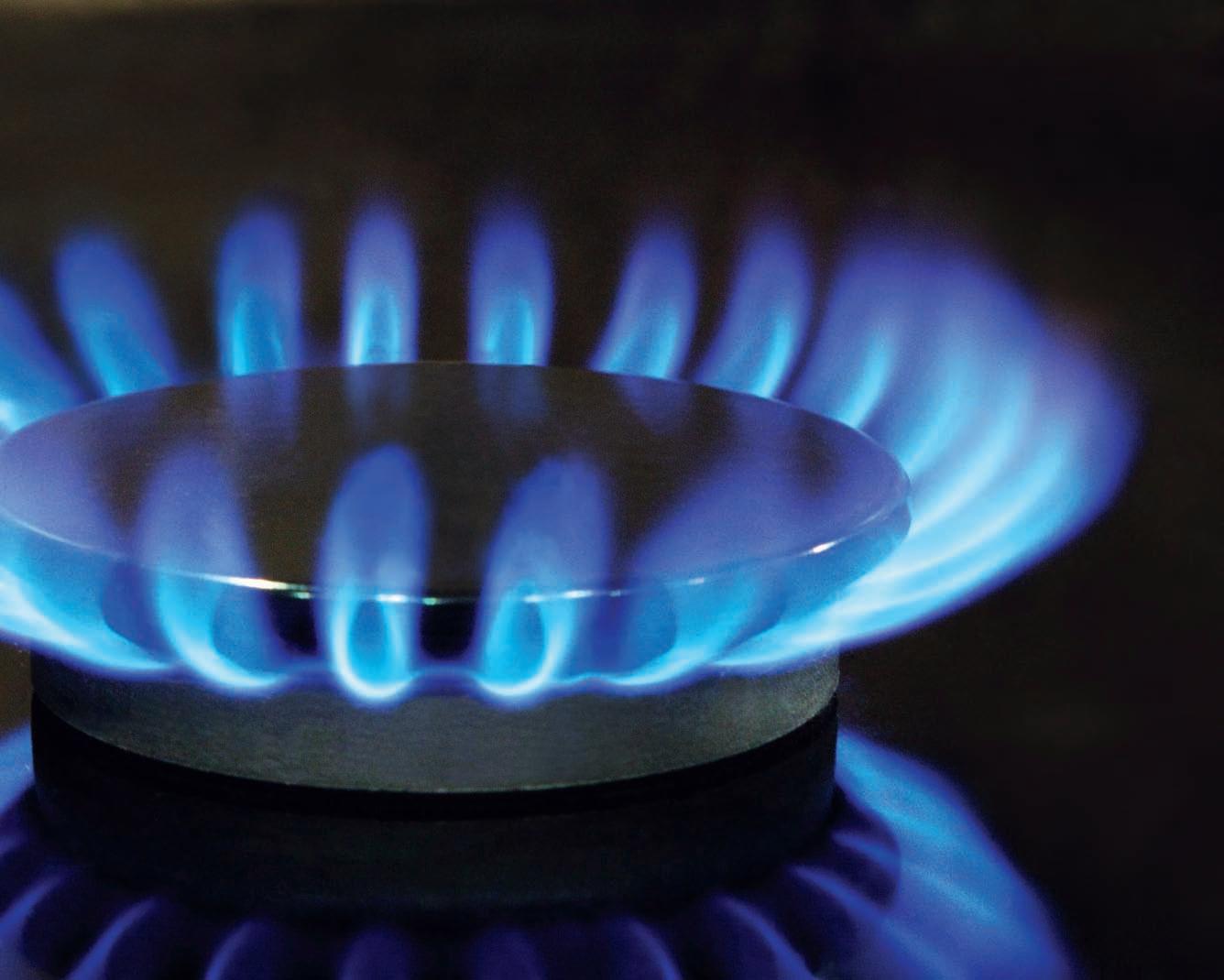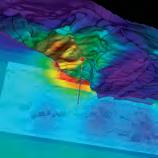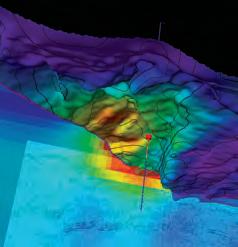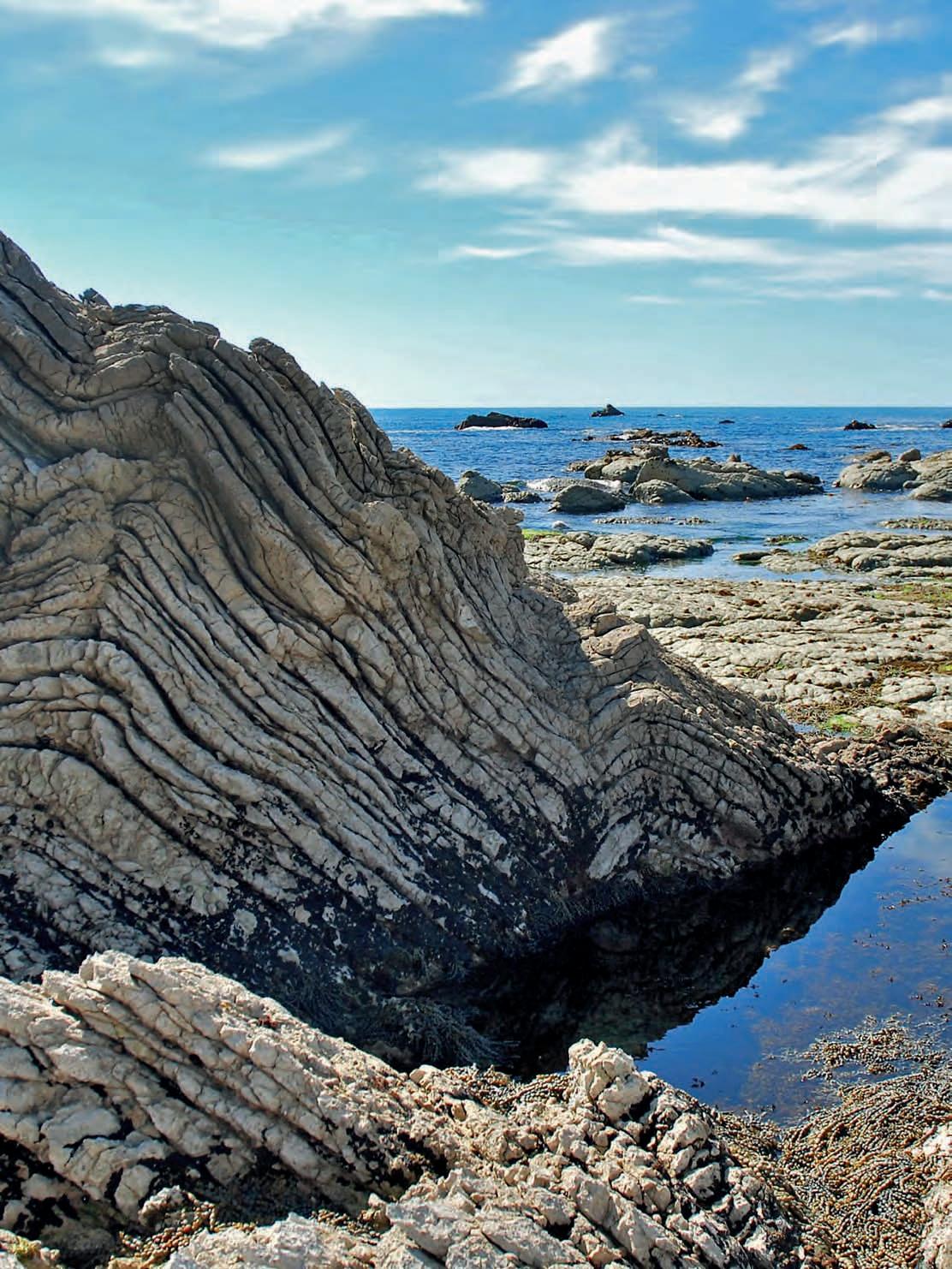

CONTINUAL TRANSFORMATION LEADS TO CONSTANT INNOVATION.
GEOSCIENCE
SOFTWARE



IHS is invested in the success of Canada’s energy industry. We maintain an open dialogue with our customers, and as a result we are launching a new IHS AccuMap® map and user interface and have delivered workflow integration between IHS Petra® and IHS Kingdom® We have also provided transparency and quality information, and created solutions for better access to global resources.
Today more than ever, partnering with IHS can make the difference between average performance and operational excellence.
Begin your transformation today. ihs.com/transform
CSPG OFFICE
#110, 333 – 5th Avenue SW Calgary, Alberta, Canada T2P 3B6
Tel: 403-264-5610
Web: www.cspg.org
Office hours: Monday to Friday, 8:30am to 4:00pm
Executive Director: Lis Bjeld
Tel: 403-513-1235, Email: lis.bjeld@cspg.org
Member Services Coordinator: Emma MacPherson
Tel: 403-513-1226, Email: emma.macphersons@cspg.org
Communications and Publications: Caitlin Young
Email: caitlin.young@cspg.org, Tel: 403-513-1230
Programs Development: Aileen Lozie
Tel: 403-513-1227, Email: aileen.lozie@cspg.org
Accounting and Office Administration: Kasandra Amaro (Klein) Tel: 403-513-1233, Email: kasandra.amaro@cspg.org
Corporate Sponsorship: Lis Bjeld
Tel: 403-513-1235, Email: lis.bjeld@cspg.org
EDITORS/AUTHORS
Please submit RESERVOIR articles to the CSPG office. Submission deadline is the 23rd day of the month, two months prior to issue date. (e.g., January 23 for the March issue).
To publish an article, the CSPG requires digital copies of the document. Text should be in Microsoft Word format and illustrations should be in TIFF format at 300 dpi., at final size. For additional information on manuscript preparation, refer to the Guidelines for Authors published in the CSPG Bulletin or contact the editor.
Technical Editors
Ben McKenzie Colin Yeo (Assistant Tech. Editor) Tarheel Exploration EnCana Corporation Tel: 403-277-4496 Tel: 403-645-7724 Email: bjmck@live.com Email: colin.yeo@encana.com
Coordinating Editor
Caitlin Young, Publications Coordinator, CSPG Tel: 403-513-1230, Email: caitlin.young@cspg.org,
ADVERTISING
Advertising inquiries should be directed to Caitlin Young, Tel: 403-513-1230 email: caitlin.young@cspg.org. The deadline to reserve advertising space is the 23rd day of the month, two months prior to issue date.
RESERVOIR is published 11 times per year by the Canadian Society of Petroleum Geologists. This includes a combined issue for the months of July and August. The purpose of the RESERVOIR is to publicize the Society’s many activities and to promote the geosciences. We look for both technical and non-technical material to publish. Additional information
Additional copies of the RESERVOIR are available at the CSPG office. No official endorsement or sponsorship by the CSPG is implied for any advertisement, insert, or article that appears in the Reservoir unless otherwise noted. All submitted materials are reviewed by the editor. We reserve the right to edit all submissions, including letters to the Editor. Submissions must include your name, address, and membership number (if applicable). The material contained in this publication is intended for informational use only. While reasonable care has been taken, authors and the CSPG make no guarantees that any of the equations, schematics, or devices discussed will perform as expected or that they will give the
information
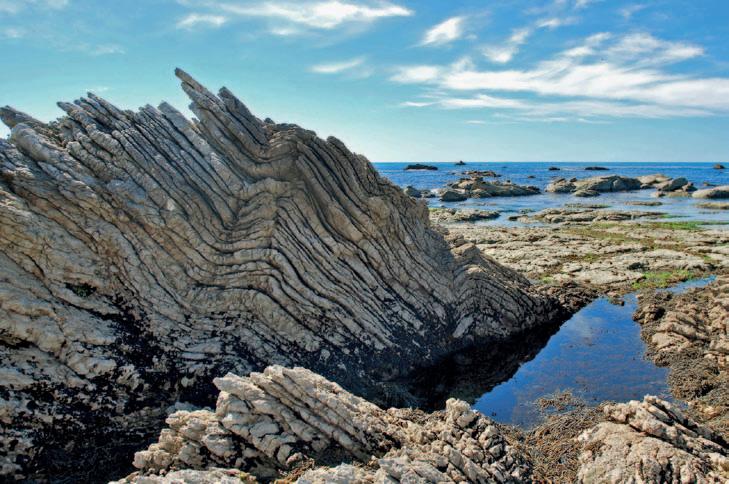
FRONT COVER The Late Oligocene Spyglass Formation, Kaikoura Peninsula, New Zealand. The cm-scale limestone layers are interbedded with less resistive, highly glauconitic, calcarious sandstones. Photo by Janelle Irvine.
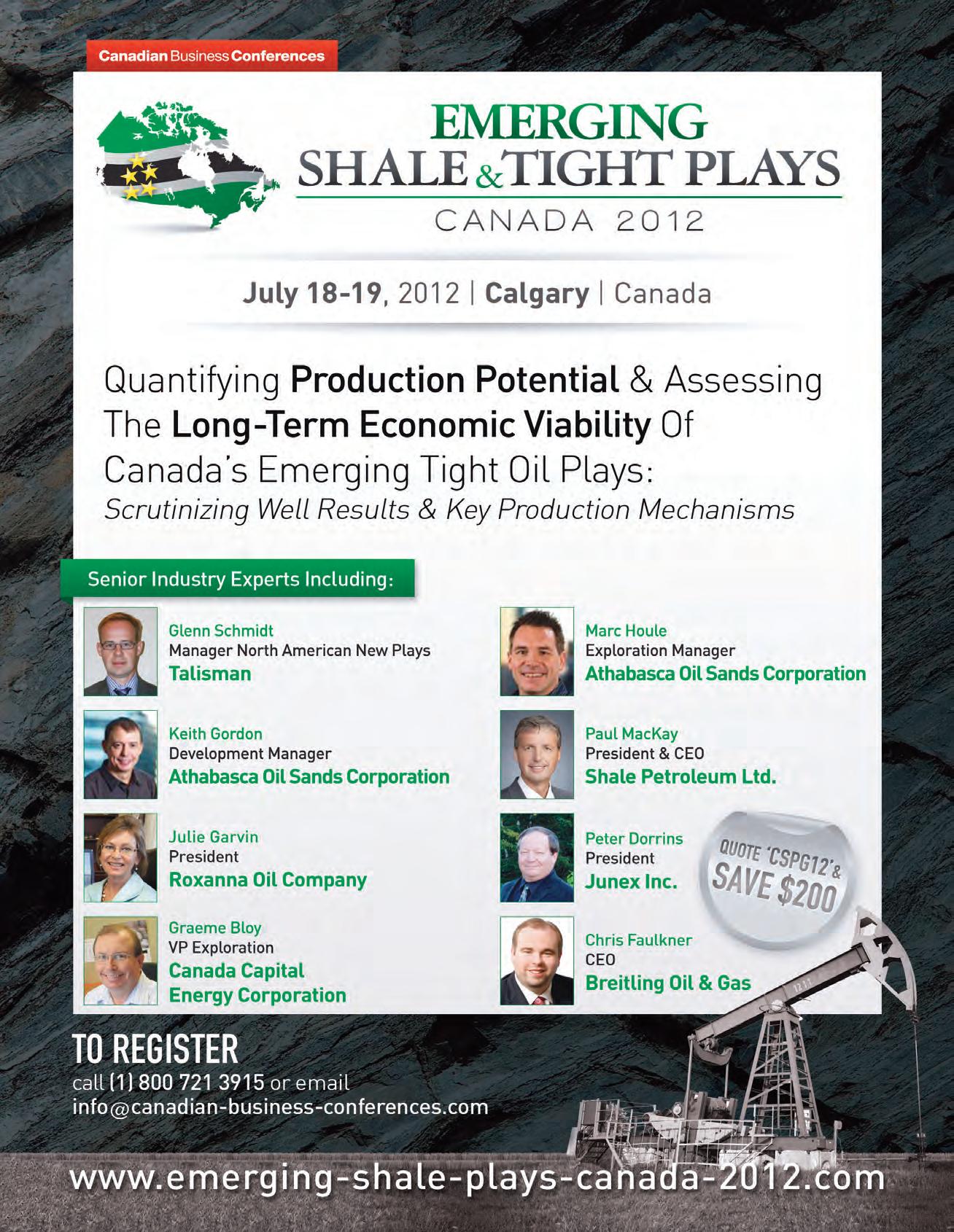

CSPG EXECUTIVE














President
Robin Mann • AJM Deloitte rcmann@deloitte.ca Tel: (403) 648-3210
Vice President
Paul MacKay • Shale Petroleum Ltd. Paul.Mackay@shalepetroleum.com Tel: (403) 457-3930
Past President
Kirk Osadetz • Geological Survey of Canada, Calgary kosadetz@nrcan.gc.ca Tel: (403) 292-7022
Finance director
Andrea Hood • geoLOGIC systems ltd. ahood@geologic.com Tel: (403) 262-1992
assistant Finance director
Samantha Etherington • CNRL samantha.etherington@cnrl.com Tel: (403) 386-6459
Program director
Jon Noad • Murphy Oil Corporation jon_noad@murphyoilcorp.com Tel: (403) 294-8829
assistant Program director
Dave Russum • AJM Deloitte drussum@deloitte.ca Tel: (403) 648-3228
serVices director
Michelle Hawke • Apache Canada Ltd. Michelle.Hawke@apachecorp.com Tel: (403) 261-1200
assistant serVices director
Mike Seifert • Canadian Discovery mseifert@canadiandiscovery.com Tel: (403) 269-3644
communications director
Jim Barclay • ConocoPhillips Canada
Jim.E.Barclay@conocophillips.com Tel: (403) 532-3889
assistant communications director
Cur tis Evans • ERCB curtis.evans@ercb.ca Tel: (403) 297-8386
outreach director
Simon Haynes • Statoil Canada Ltd. sihay@statoil.com Tel: (403) 724-0364
assistant outreach director
Dawn Hodgins • Imperial Oil Resources
dawn.hodgins@exxonmobil.com Tel: (403) 232-5931
executiVe director
Lis Bjeld • CSPG lis.bjeld@cspg.org Tel: (403) 513-1235
EXECUTIVE COMMENT
A Message from Simon Haynes, 2012 Outreach Director
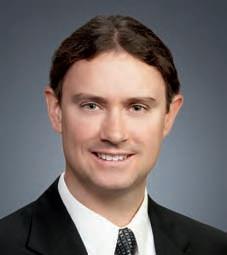
As I sit down to write this article it is early June.
The 2012 Joint Annual Conference has just finished, the final round of the Stanley Cup playoffs is in full swing, students are working away at their summer jobs, the weather almost promises there will be no more snow (or at least anything significant that will accumulate in my driveway) and for Outreach, it is an opportunity to take a breather before the back-to-school fall rush begins.
Outreach is an important pillar for the CSPG. I compare it to a research division of a large company, or a long-term financial investment. There is no guarantee of a payout – actually Outreach is the one area of the CSPG that consistently in the red –financially. Every year we spend a significant amount in terms of volunteer hours and dollar amounts to ensure that our programs are successful. By this I refer to the attraction of students to petroleum geoscience, and communicating what the CSPG is and does. In terms of metrics, it is difficult to provide exact figures as to how much influence we are having on recruitment, or how effective we are at reaching people outside of our current membership. But there are a few examples we can cite.
In 2010, we examined our current portfolio, and ranked individual programs in terms of impact on various target audiences. In order of importance we had university students, other students (public through high school), teachers, and members of the general public. University students were deemed the most valuable as they are already focussed on earth science and we are confident that we can attract a significant portion of the top students specifically to petroleum geosciences. To this end, we rely on the Student Industry Field Trip (SIFT) program, which has been running continuously since 1978. For those unfamiliar with SIFT, the CSPG selects a student from each Canadian University that offers an undergraduate degree in Earth Science to attend a twoweek intensive course in Calgary in early
May. In the last 34 years, there have been over 1,100 students participate. I went on SIFT in 1997, and 12 out of our original group of 34 are still actively working as petroleum geologists.
Over the last decade, the University Outreach Committee has developed and strengthened relationships with universities, students, and professors, outside of the SIFT program. There are many more students who are interested in petroleum geology than have the opportunity to participate in SIFT, so the UO Committee focuses on bringing the CSPG brand and an overview of our industry to them. UO has consistently provided financial support and sent volunteers to each of the major Canadian Geoscience student conferences in Canada –the AUGC (Atlantic Universities Geoscience Conference), the Western Inter-University Geoscience Conference (WIUGC), and AESRC (Applied Earth Science Research Conference). The volunteers set up a booth to promote our society, talk to students about career options, and act as judges for the student presentations. Our presence is well received, and feedback from the conference organizers tells us that students are excited to have CSPG attend their conventions, as it is clear evidence we are interested in their work. UO also coordinates the Fall and Spring Lecture Tour series, where a CSPG volunteer will visit two to five Canadian earth science departments to give a technical talk aimed at a 3rd- to 4th-year undergraduate level. A number of universities have taken the initiative to contact us every year to ask to be included on these tours, so clearly our reputation is preceding us!
Admittedly, most of our current Outreach portfolio tends towards promotion and recruitment for both our industry and the CSPG. This is partly to help provide a unified approach to the promotion of petroleum geoscience as a viable career (Continued on page 7...)
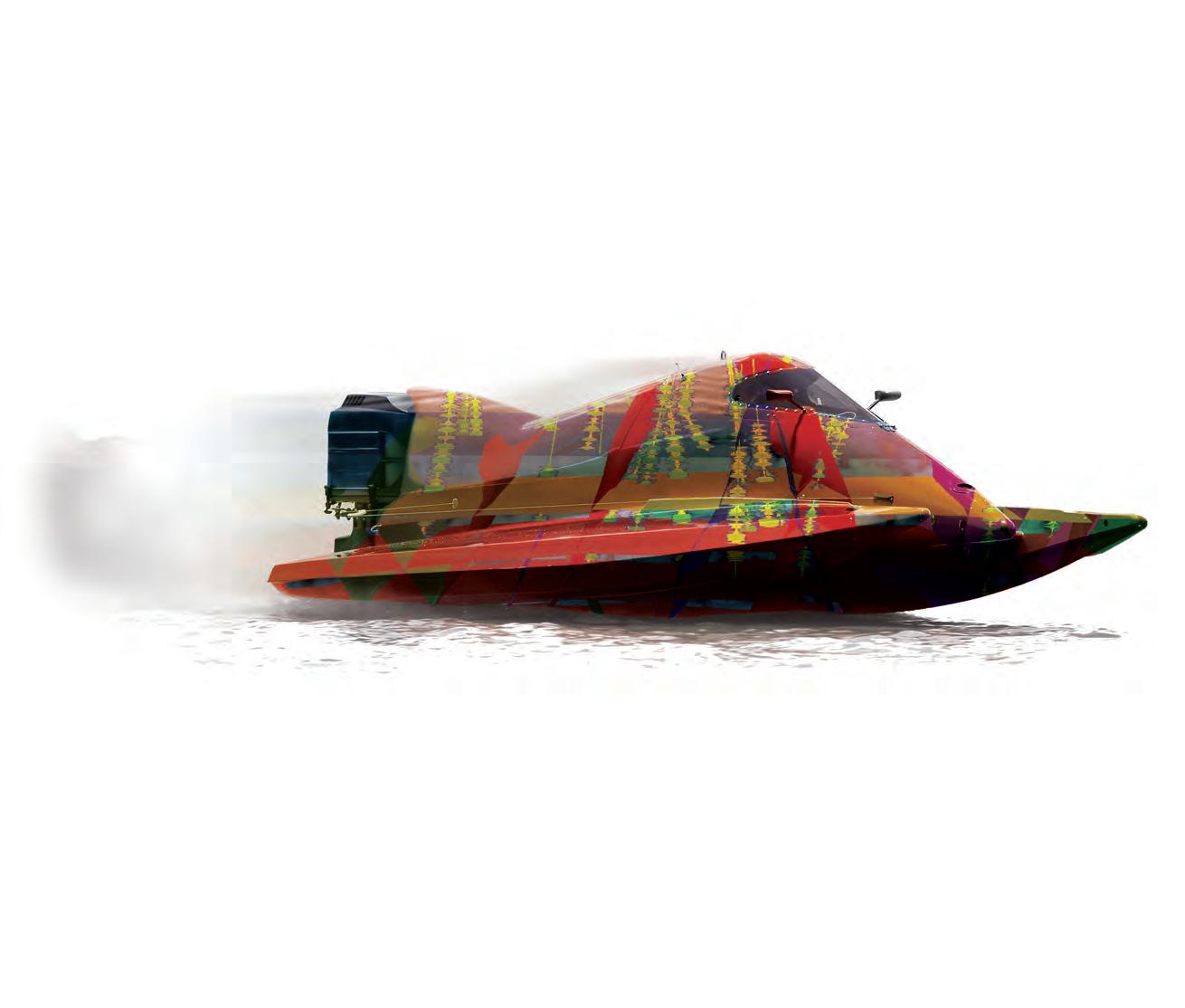
DecisionSpace® Desktop software automatically generates accurate sealed frameworks in about a minute.
As geoscientists interpret data, Landmark’s new unified DecisionSpace® Desktop software automatically constructs fault networks, seals horizons against the fault network and generates a sealed framework. When geologists make picks or geophysicists interpret sections, watch live updates ripple through the framework and then create accurate, report-quality maps instantly. What once took hours, or even days, now takes just a minute. So speed up your cycle time. Get better answers faster. Visit halliburton.com/decisionspacedesktop.
High Science Simplified®

CORPORATE SPONSORS
Diam OND
IHS
GEOLOGIC SYSTEMS LTD
SCHLUMBERGER CAnADA LTD
PL aTi N um
CEnOVUS
COnOCOPHILLIPS
EnC AnA
IMPERIAL OIL
nE xEn InC
SHELL
TALISMAn EnERGY
POGGEnPOHL
GOLD
APEGA
CSPG EDUCATIOnAL TRUST FU nD
DEVOn CAnADA
WEATHERFORD L ABOR ATORIES
Si Lve r EnERPLUS
JEWEL SUITE
ROx AR
TAqA nORTH
BrONZ e
ATHABASCA OIL SAnDS
BAkER ATLAS WIRELInE
BLU EBACk RESERVOIR
PAR ADIGM
GEOVARIAnCES
CSEG FOU nDATIOn
HUSkY EnERGY
LED SIGn S
LITTLE ROCk DOCUMEnT SERVICES
LORInG TARCORE LABS
MACqUARIE CAPITAL MARkETS
CAnADA LIMITED
ROkE TECHnOLOGIES
RPS BOYD PETROSEARCH
HALLIBURTOn EnERGY SERVICES
SU nCOR EnERGY
SU nDOG PRInTInG
WEATHERFORD CAnADA PARTnERSHIP
AS OF JUNE 10, 2012
(...Continued from page 5)
option, but also we have found that some of the CSPG’s most active volunteers’ first experiences were through programs like SIFT. Currently, our main public program is the Honorary Address, which brings in one or two speakers involved in the earth sciences to speak with a general audience. This event is held at SAIT in the late fall, and consists of a daytime program to bus in junior high students, and an evening program that is more focussed on adults. This year’s Honorary Address is a joint session by Dr. Trent Rehill (2011 CSPG Tracks Award winner), who will be speaking about oil exploration in Africa, and Dr. Ian Tattersall, an anthropologist from the American Museum of natural History, whose work has focussed on human evolution. The title of the joint talk is “From Evolution to Exploration: Our African Journey”. It will be an interesting evening and we hope to see many of you there.
Recently I had a conversation with our Outreach counterparts at the CSEG. They have followed a different path, made a stronger effort with the general public and elementary through junior high school children, and place far more emphasis on
general science education. Their volunteers spend a great deal of time at high school career fairs across the country. We are looking to expand our efforts in this area, but are constrained not as much by funding, but by a lack of a core group of volunteers. We are currently looking for a group of folks within the CSPG who are interested in working with children. If you do have an interest in this particular field (or for that matter, any other aspect of Outreach), please call into the CSPG office and provide us with your name and contact information. We know we can do a lot more to develop public programs, but it has to come from within the general membership – this will not be a top-down initiative.
Our Outreach portfolio relies on a dedicated group volunteers to ensure that the programs are well-run and organized. I do not have the space to recognize them all individually, but those involved in the SIFT, University Outreach, Honorary Address, and the ESFS committees are especially thanked on behalf of the CSPG for their contributions to, and the promotion of, Canadian petroleum geoscience.
Seismic Data Room Rental Service (two secure private data rooms)
Divestiture Seismic Data Room Support (four portable workstations)
Seismic Project Conversions (between interpretation software)
Seismic Data Loading Service
Synthetic and 2D Model Generation
Georeference Service (Coordinate Transformation of Raster Images)
Geographic Coordinate Conversion Service
Well Location Plat Generation
Seismic Data Management Service
Professional Montage Display
technicaL Luncheons SEPTEMBER LUNCHEON
The Dodsland Viking tight oil play: stacked wave-reworked, shallow shelf deltas
SPEAKER
J. e dwa rd m ath ison Alethia Geologica
11:30 am
tues day, september 11, 2012 te Lus convention centr e c algar y, a lbe rta
Please note: t he cut-off date for ticket sales is 1:00 pm, Wednesday, s eptember 5, 2012. csPg m ember t icket Price: $42.00 + gst n on- m ember t icket Price: $45.00 + gst
Eac h CSPG Technical Luncheon is 1 APEGA PDH credit. Tickets may be purchased online at www.cspg.org.
Horizontal well technology combined with multi-stage fracturing (HWMF) has revolutionized the oil industry over the last decade (although high oil prices have not hurt). This has led to revitalization of a number of Viking light oil reservoirs in west-central Saskatchewan. In addition, new conceptual tools have been forged and old tools refined that allow reassessment of shallow shelf, tight sand reservoirs. Application of these new and refined conceptual tools to the Viking Dodsland reservoir trend allows reinterpretation
of the depositional/erosional events that shaped these reservoirs. This in turn facilitates precise, high-resolution reservoir mapping. High-resolution mapping enhances HWMF application by optimizing both well placement and trajectory.
The Viking Formation, forming the Dodsland trend of Saskatchewan, is an amalgamation of three severely toptruncated deltaic units (Viking 3 to 1 in descending order). The lower two units, Viking 1 and 2, are the most productive reservoir zones. Distal delta front to distal prodelta sediments bearing a stressed proximal to distal Cruziana ichnofacies are the only sediments preserved of the constructive phases of delta growth for these sedimentary packages. More proximal facies (i.e., proximal delta front, distributary channels, stream mouth bars, delta plain, etc.) were stripped off during destructive phases of deltaic cycles. Sediments above the wave ravinement surface formed during delta destruction comprise two distinct facies representing different marine processes. Regionally extensive chertrich layers (pebbles to coarse sands with interlaminated mudstones) record delta abandonment and shoreface retreat with coarse (proximal delta front to delta top) sediments, being re-deposited on the distal delta front and prodelta. During the early stages of delta destruction of deltaic cycles 1 and 2, proximal deltaic sediments were reworked by trangressive submergence, into elongate submarine bars (inner shelf shoals). These fine- to medium-grained shoal sands, bearing a stressed Skolithos-Cruziana ichnofacies characterized by abundant robust Teichichnus and Palaeophycus, were ultimately deposited in a lower shoreface
Webcasts sponsored by
setting. A regional erosion surface, the VE 4 surface of Boreen and Walker (1991), progressively truncates the entire reservoir assemblage from south to north, ultimately intersecting the underlying Viking B deltaic assemblage along the northern margin of the Dodsland trend.
Within the context of the Viking Formation of west-central Saskatchewan the lower two Viking units of the Dodsland trend (Viking 1 and 2) are distinct depositional events despite being coextensive with Viking reservoir units to the south that form the Verendrye, Forgan, Elrose, Plato, n ort h Plato, and Fiske pools. These relationships imply delta-lobe switching within successive trangressive-regressive episodes. Viking unit 3 is a single deltaic succession that blankets the entire area. The Viking 1 deltaic lobe, south of Dodsland, was reworked by transgressive submergence to form an inner shelf shoal that comprises the main reservoir of the Plato pool. Distal and proximal delta front sediments and chert pebble “lags” are the most prolific portions of the southern Viking 2 delta lobe and Viking 3 delta. These successions are coarser grained than in the Dodsland trend and reflect both higher energy conditions and more proximal settings during deposition.
Within a sequence stratigraphic framework, the Viking deltaic cycles of west-central Saskatchewan record high-frequency lowstand events that punctuate highstand progradation. These sedimentary packages can also be explained by a loss of accommodation space resulting from a clastic wedge building into a foreland basin. Viking sediments of west-central Saskatchewan are southwesterly derived and represent the most basinward extension of the Bow Island sediment source. They are also stratigraphically higher and therefore younger than westerly derived Viking clastics to the north that comprise the kerrobert Viking pool reservoir.
The Viking pools of west-central Saskatchewan are conventionally trapped tight-sand reservoirs that were deformed by later salt dissolution into their present configuration. In addition, small-scale faulting has affected the reservoirs locally. Weak groundwater recharge into these low-permeability rocks has resulted in disequilibrium amongst reservoir fluids. High-permeability oil zones and gas-
charged portions of reservoirs that have been dropped by post hydrocarbon migration salt dissolution into the water column are flushed of hydrocarbons whereas low-permeability oil zones are incompletely swept and retain high residual oil saturations.
Understanding the primary depositional architecture of the Viking deltaic packages and associated facies distribution is critical to planning and implementing HWMF programs in the west-central Saskatchewan. Optimum well placement, in turn, is essential to a successful HWMF projects. Understanding the post oilmigration history of the reservoirs is necessary to understanding present-day fluid distribution and the resultant impact on hydrocarbon production.
REFERENCES
Boreen, T. and Walker, R.G. 1991. Definition of allomembers and their facies assemblages in the Viking Formation, Willesden Green area, Alberta. Bulletin of Canadian Petroleum Geology, v. 39, p. 123-144.
BIOGRAPHY
“A good traveler has no fixed plans and is not intent on arriving.”
Lao Tsu
I began my journey into geology via a correspondence course in high school driven by the need for a third science in order to attend university. The main appeal was that I didn’t want to work in an office. After a brief flirtation with Anthropology (I was brought to my senses by a course in the systematics of cultural anthropology), I found my true calling. A few field seasons searching for lead/zinc in Ordovician carbonates in the High Arctic confirmed my choice and led to the realization that carbonates and their contained fossils were my true passion (sandstones were so blasé). Spurred by a desire to follow my true calling and a lack of jobs, I decided to pursue a Master’s degree in micropalaeontology at the University of Saskatchewan, an eminently practical choice for a would-be petroleum geologist. A few years of staring down a microscope and a lack of jobs in micropalaeontology convinced me that this was not my destiny so I logically accepted a job searching for uranium in Precambrian sandstones. After three years
GeoEdges Inc.
GeoGraphix, ArcGIS, AccuMap, GeoScout and other applications
in the mineral industry, a combined total of seven summers in the “bush,” and two long winters coupled with the arrival of our daughter, field geology lost its sheen and I accepted an office job in an oil company.
Through my 30+ years in the oil industry I have worked on both domestic and international projects in a variety of basins: rift, trans-tensional, and foreland, dealing in clastics from Cambrian to Tertiary in age. I have worked in large multinational to small domestic oil companies and consulted both independently and in large consulting firms. I have given numerous talks, principally on clastic sequence stratigraphy, sedimentology, and hydrocarbon trapping. I have authored and co-authored several papers on Devonian micropalaeontology/biostratigraphy, and various aspects of Mannville Group sequence stratigraphy, sedimentology, bio-geochemistry, and reservoir geology. I still believe that geology is fundamentally a field science, but can also be explored on a computer screen from a desk, although sometimes a rock hammer would be handy!
for information contact: Joel Harding at 403 870 8122 email joelharding@geoedges.com www.geoedges.com
Western Canada: Slave Point, Swan Hills, Leduc, Grosmont, Jean Marie, Horn River Shales, Elkton, Shunda, Pekisko, Banff, Mississippian subcrops and anhydrite barriers in SE Sask., Bakken, Three Forks, Montney, Halfway, Charlie Lake, Rock Creek, Shaunavon, BQ/Gething, Bluesky, Glauconitic, Lloyd, Sparky, Colony, Viking, Cardium, Horseshoe Canyon and Mannville CBM, Oilsands Areas, Outcrops
US Rockies & Williston: Red River, Mississippian subcrops & anhydrite barriers (Bluell, Sherwood, Rival, etc), Bakken, Three Forks, Cutbank, Sunburst, Tyler, Heath, Muddy, Dakota, Sussex, Shannon, Parkman, Almond, Lewis, Frontier, Niobrara, Mesaverde shorelines, Minnelusa, Gothic, Hovenweep, Ismay, Desert Creek, Field Outlines, Outcrops
North American Shales: Shale plays characterized by O&G fields, formation limit, outcrop, subcrop, structure, isopach, maturity, stratigraphic cross-sections. Includes: Marcellus, Rhinestreet, Huron, New Albany, Antrim, Utica-Collingwood, Barnett, Eagleford, Niobrara, Gothic, Hovenweep, Mowry, Bakken, Three Forks, Monterey, Montney, Horn River, Colorado
Appalachian Basin: PreCambrian, Trenton, Utica-Collingwood, Medina-Clinton, Tuscarora, Marcellus, Onondaga Structure, Geneseo, Huron, Antrim, New Albny, Rhinestreet, Sonyea, Cleveland, Venango, Bradford, Elk, Berea, Weir, Big Injun, Formation limits, Outcrops, Allegheny Thrust, Cincinatti Arch, Field outlines
Deliverables include:
-Shapefiles and AccuMap map features
-hard copy maps, manual, pdf cross-sections
-Petra Thematic Map projects, GeoGraphix projects, ArcView map and layers files
-bi-annual updates and additions to mapping
-technical support
technicaL Luncheons SEPTEMBER LUNCHEON
Using
high resolution chemostratigraphy to determine wellbore pathways in multilateral drilling campaigns:
an
example from the Horn River Formation, British Columbia, Canada
SPEAKER
Gemma Hildred Chemostrat
11:30 am
Wednesday, september 19, 2012 teLus convention centre calgar y, alberta
Please note: the cut-off date for ticket sales is 1:00 pm, thursday, september 13, 2012. csPg member ticket Price: $42.00 + gst. non-member ticket Price: $45.00 + gst.
Each CSPG Technical Luncheon is 1 APEGA PDH credit. Tickets may be purchased online at www. cspg.org.
ROCK SHOP

Shale resource plays have risen to the forefront of hydrocarbon exploration over the last decade. However, the fine-grained, macroscale homogeneity of most shale plays negates some of the more traditional approaches to reservoir characterization and stratigraphic correlation. A common problem is that shale accumulation in restricted basins limits the use of biostratigraphy, and palynomorphs are often thermally degraded. Electric-log correlations are also hampered by the variable controls on U, k, and Th and the recognition of sedimentary facies is made especially difficult when only cuttings samples are available.
Furthermore, shale resource plays are often exploited using horizontal drilling, a technique that requires drilling to, and staying within, a targeted zone. A recent study conducted by Halliburton revealed “approximately 50% of wells geosteered using the conventional gamma-ray geosteering methods within an area of the Haynesville were misplaced for more than 50% of their lateral length.” (http://www.epmag.com/Production-Drilling/ Geosteering-Unconventional-Shale-ReservoirsPotential_80771). The challenge, then, is to define a stratigraphic framework that will repeatedly allow accurate placement of the wellbore within the “sweet spot” in a multilateral drilling campaign. Inorganic whole rock geochemical data can be used to meet this challenge.
Using examples from the Horn River Formation, this talk will demonstrate how a high-resolution stratigraphic framework can be used to precisely locate lateral wellbores relative to a pilot hole. A robust chemostratigraphic zonation has been established for the Evie, Otter Park, and Muskwa members of the Horn River Formation in
Webcasts sponsored by
northeastern British Columbia using variations in inorganic whole rock geochemical data. In this example, chemostratigraphy is used on two vertical wells to subdivide the Horn River Formation into five geochemical packages and nine higher resolution geochemical units based on variations in key elements (U and CaO), element ratios (Si/Zr, Th/U), the enrichment factor of vanadium (EFV), and terrigenous input.
Chemostratigraphy can provide regional correlations of shale reservoirs to help in understanding broad, basinal stratigraphies and events. Additionally, changes in inorganic geochemical data can be used to determine wellbore pathways in multilateral drilling campaigns. Because these data can be acquired rapidly and at wellsite, this application has large potential in the Horn River Basin and beyond. Furthermore, the same dataset can be used to model mineralogy and rock properties, identify anoxic conditions, differentiate biogenic and detrital silica, and in some cases, can be used to understand how shale stratigraphy may be interpreted in a sequence stratigraphic context.
BIOGRAPHY
Gemma Hildred graduated from the University of Birmingham with an M.Sc. Honours degree in geology in 2006. Gemma began her career at Chemostrat Intl. Ltd. in 2006 and is now a senior geologist at Chemostrat Inc. in Houston, overseeing proprietary work throughout North America. Gemma also continues to research and publish work on the applications of inorganic whole rock geochemical data to geosciences and to the oil industry, specifically studying low accommodation fluvial sequences in Western Canada and the chemostratigraphic characteristics of the Eagle Ford Formation, West Texas.


petrographical & sedimentological descriptions for samples (thin section - fluid inclusion studies) conventional vertical/horizontal wells operations geology

RJWDOUGLASMEDAL
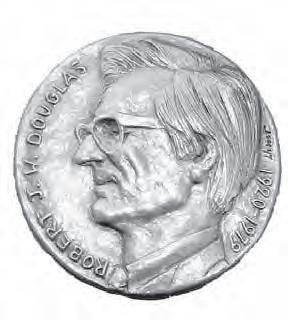

The award is open to all geologists who follow the example of Bob Douglas in contributing to the development of Canadian sedimentary, petroleum, and structural geology.
Nominations for the award of the medal must be endorsed by at least three members of the CSPG. Nominations may be proposed at any time, but to be considered for a particular year, they must be received by the Society before September 1
The sponsors of a nominee for the award should supply:
A curriculum vitae (outling the nominee’s career and previous honours or distinctions).
A list of publications by the nominee.
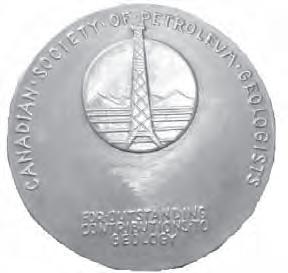

A summary of the nominee’s achievements in a form suitable for use as a citation for the award.
The RJW Douglas Medal is awarded annually by the Canadian Society of Petroleum Geologists for outstanding scientific contributions to the understanding of sedimentary geology in Canada, commending major contributions to regional tectonics, petroleum, and structural geology. 1. 2. 3. 4. in 5.
An analysis of the nominee’s achievements, highlighting the contributions for which he or she is being recognized, and relating these to the appropriate publications in the bibliography.
The last item of information is a key part of the nomination and should convey the magnitude and scope of the nominee’s scientific contributions, with comments on the influence that these contributions have had on others. An example of a submission may be provided on request.
Completed nominations should be sent to:
Margot McMechan
CSPG Douglas Medal Committee Chairman, c/o Margot McMechan
GSC – Calgary
3303, 33rd Street NW, Calgary, Alberta T2L 2A7
Telephone (403) 292-7154
Email: mmcmecha@nrcan.gc.ca
technicaL Luncheons OCTOBER LUNCHEON
The Tagish Lake meteorite: clues to ‘maturation’ of organic matter in the early solar system
SPEAKER
Dr. Chris Herd
Smithsonian Institution’s n ational Museum of n atural History
11:30 am
tues day, o cto ber 9, 2012 te Lus convention centre calgar y, a lbe rta
Please note: the cut-off date for ticket sales is 1:00 pm, monday, october 1, 2012. csPg member ticket Price: $42.00 + gst non- member ticket Price: $45.00 + gst
Each CSPG Technical Luncheon is 1 APEGA PDH credit. Tickets may be purchased online at www.cspg.org.
The complex suite of organic materials in carbonaceous chondrite meteorites probably originally formed in interstellar space and/or the solar protoplanetary disk, but was subsequently modified in the meteorites’ asteroidal parent bodies. The mechanisms of formation and modification are still very poorly understood. We carried out a systematic study of variations in the mineralogy, petrology, and soluble and insoluble organic matter in distinct fragments of the Tagish Lake meteorite. The circumstances of this meteorite’s fall and recovery enable new insights into pre-terrestrial organic matter variability. The variations correlate with indicators of parent body aqueous alteration, and at least some molecules of importance for life on Earth formed during the alteration.
BIOGRAPHY
Dr. Chris Herd is a geologist whose interests are many and varied, and best described under the heading of comparative planetology. He
has a fascination with the origin and geologic evolution of planets in the solar system. Dr. Herd completed his undergraduate degree in Geological Sciences at Queen’s University in 1997. His interest in working on meteorites from Mars took him to the University of New Mexico in Albuquerque for his Ph.D., which was fully funded by a NASA graduate fellowship. In 2001 he moved to the Lunar and Planetary Institute in Houston, where he worked as a postdoctoral fellow with access to the facilities at the Johnson Space Center. He was hired in July of 2003 at the University of Alberta as assistant professor in the Department of Earth and Atmospheric Sciences, and was awarded tenure in July 2008. He teaches Mineralogy and Planetary Geology for the Geology program, and is the curator responsible for the Alberta Meteorite Collection, the largest University-based meteorite collection in Canada. In 2006, he led the consortium purchase of the pristine specimens of the organic-rich Tagish Lake meteorite. He recently returned from a year-long sabbatical at the Smithsonian Institution’s National Museum of Natural History in Washington, D.C., and is now supervising the construction of a unique facility for the curation of pristine meteorites.

technicaL Luncheons OCTOBER LUNCHEON
An Arctic Perspective on 20th Century Warming
SPEAKER
Gifford m ille r
University of Colorado, Boulder, CO
11:30 am
tue sday, o cto ber 23
te L us c onven tion c entr e c algar y, a lbe rta
Please note: the cut-off date for ticket sales is 1:00 pm, Wednesday, october 17, 2012. csPg member ticket Price: $42.00 + gst. non-member ticket Price: $45.00 + gst.
Each CSPG Technical Luncheon is 1 APEGA PDH credit. Tickets may be purchased online at www.cspg.org.
Over the past century our planet has warmed about 1.5°F. We know this from thermometers that have recorded temperatures around the planet. It is a fact. The more interesting questions are “Why?” and “Is the warming part of a natural cycle, or related to something we humans are doing?” The planet has been hotter and colder in the past, can this be just part of a longer climate cycle? Despite being remote and inhabited by few people, the Arctic is an ideal region to try to answer these key questions because temperature changes are always larger in the Arctic than elsewhere in the northern Hemisphere. This is because of the strong positive feedbacks from snow, plants, and sea ice. So the signal is much larger and clearer in the Arctic than elsewhere. A little-noticed Arctic study by a Canadian geographer in the 1960s demonstrated that some ice caps preserve rooted tundra plants that are revealed as the ice margin recedes. We have capitalized on this observation to derive an extensive database of vegetation “kill dates” from which we can place the current warming in a millennial perspective and help to explain the occurrence of severe climate perturbations such as the Little Ice Age (1300-1850 AD). I will review how studies in the Arctic help to place the warmth of the past century in a longer-term perspective to try to get a better understanding of what this warming means.
Webcasts sponsored by
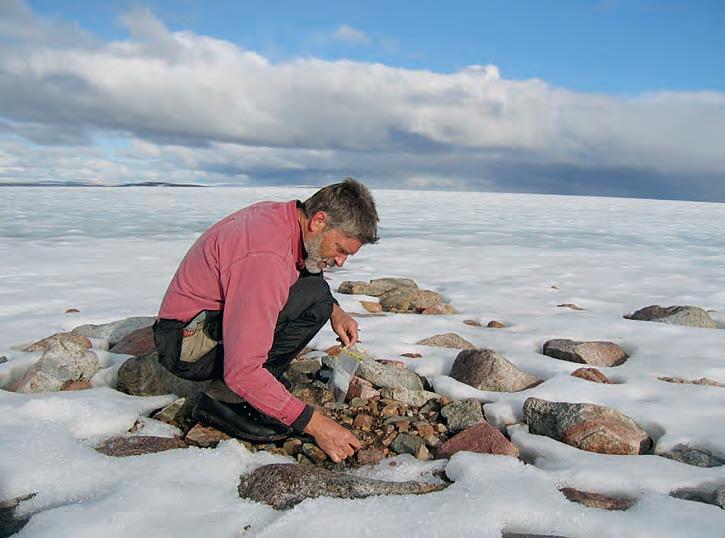
BIOGRAPHY
Gifford Miller, Ph.D.
Professor of Geological Sciences and Fellow, Institute of Arctic and pine Research (INSTAAR), University of Colorado at Boulder. Director, Center for Geochemical Analysis of the Global Environment (GAGE).
As a Quaternary Geologist, Gifford focuses his research on reconstructing the behavior of the climate system in the recent past as a means of improving our understanding of natural climate variability. He has conducted extensive field campaigns in the Eastern Canadian
Arctic, Iceland, and Svalbard that focus in reconstructing past environmental change and deriving inferences about the associated climates that lead to those changes. He has also had an active field program in Australia for more than 20 years, where he is studying the impacts of human colonization on a continent that never had humans, or even placental mammals. Gifford was elected a Fellow of the American Geophysical Union and the Geological Society of America, where he was recipient of the Easterbrook Distinguished Scientist Award. He is also a Foreign Member of the Norwegian Academy of Science and Letters.

ROCK SHOP
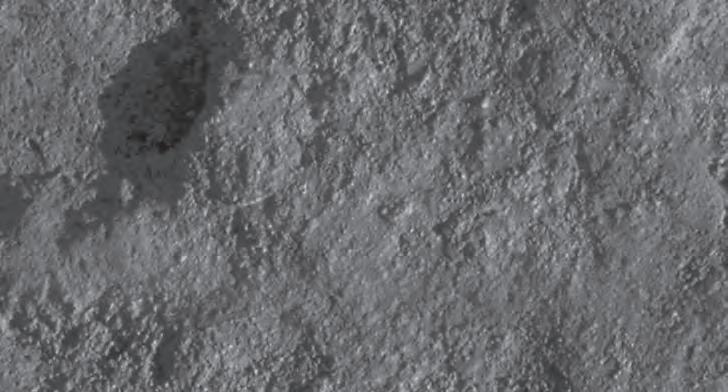

T.I.H. Consulting Ltd.

Geologic Well-Site Supervision
1602 – 5th St N.E.
Calgary, AB T2E 7W3
Phone: 403-233-7729
www.tihconsulting.com
e-mail: tih@shaw.ca
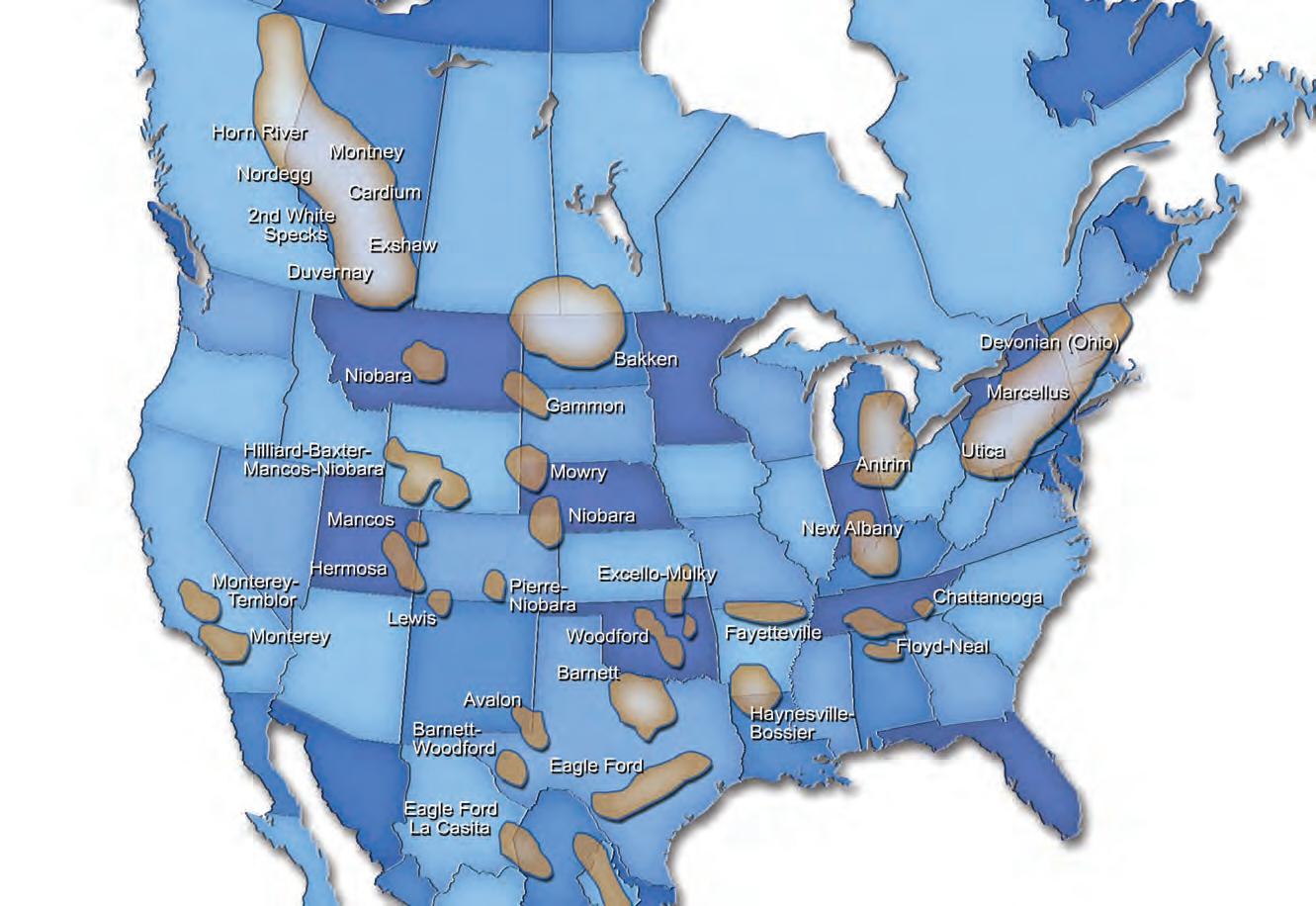
In today’s environment, opportunities are gone as quickly as they appear. Very few organizations have the resources to stay current with developing trends as well as proven reservoirs. Many organizations are forced to make quick decisions about opportunities in reservoirs they may not fully understand.
NuTech Energy Alliance works with clients to shorten learning curves. As a leader in unconventional reservoir characterization, NuTech’s clients make faster decisions resulting in earlier commercial returns. NuTech provides the resources and a database of comparative knowledge to significantly impact our client’s decision-making process.

M ICROSEISMIC H YDR AULIC F RAC TURE MON ITORING: Part 5 Geomechanics
| By Shawn Maxwell, Schlumberger
I NTRODUCTION
This article is the fifth in a series on microseismic monitoring of hydraulic fractures and focuses on geomechanical deformations associated with the microseismicity. Previous articles have described the use of microseismic to image hydraulic fracture growth and geometry, based primarily on the timing and location of the microseismicity. However, with careful geophysical analysis, the microseismic deformation can also be determined in terms of the fracture strain that results in the source of the observed microseismic signals. The microseismic strain or deformation is potentially of interest, since the deformation associated with the hydraulic fracture controls the fracture dilation and complexity and ultimately the effectiveness of the stimulation. Here a comparison is made between the microseismic deformation and the total deformation occurring with the hydraulic fracturing in order to understand the rock physics of what exactly the microseismicity tells us about the hydraulic fracturing. Part 6 of the series will follow on with a description of how the microseismic deformation can be used to validate a geomechanical simulation of the hydraulic fracture, and ultimately to create a reservoir simulation of the well performance and reservoir drainage associated with the production from the hydraulically stimulated reservoir.
Microseismic activity is generated by instantaneous geomechanical strain or slip, which can be characterized using analysis methods developed for tectonic earthquake studies (see Gibowicz and kijko, 1994 for a comprehensive review). The most common microseismic source characteristic is the magnitude or strength of the microseismic sources that has been previously described in terms of potential recording biases and identifying possible fault interaction. Stress release, area and displacement of the seismic slip can also be estimated. Another form of analysis involves seismic source mechanism studies, which examine the seismic radiation characteristics in different directions to define the fracture plane orientation and if the deformation is shearing and/or opening or closing. These earthquake techniques have slowly begun to be applied to hydraulic
fracture monitoring, in attempts to gain insight into the fractures beyond simply mapping geometry – sometimes referred to as “beyond dots in the box”. It is naturally attractive to use all aspects of the microseismic data to help understand the hydraulic fracturing process and potential effectiveness. Fracture engineering has been challenged for several years to simulate the fracture mechanics of complex hydraulic fractures, as illuminated by microseismic monitoring of reservoirs such as the Barnett Shale. This suggests that the geomechanics is also a complex issue (Cipolla et al., 2010). Microseismic provides an important and unique piece of this complex geomechanical puzzle.
H YDR AULIC F RAC TURE
GEOM ECHANICAL DEFORMATION
In the following discussion, various aspects of the deformation associated with microseismic events and the underlying hydraulic fracture are presented and contrasted. The relationship between these two aspects is relevant to the rock physics and geomechanics of the deformations associated with the microseismic and total fracturing of the rockmass. In the following discussion, the mechanics, rate, and energy of the hydraulic fracture and microseismic will be compared. For context, the reader may find it useful to contrast these discussions with a traditional geophysical seismic source such as a vibrator, which is specifically engineered to provide consistent characteristics with the desired seismic waves. Vibrator sweeps are designed to maximize power within the seismic bandwidth, and the mechanical vibrations are designed to maximize coupling to efficiently create seismic waves in the subsurface. In the case of hydraulic fracturing, however, the microseismic waves are indirectly generated by the high pressure injection to stimulate flow into the well. never theless, it is informative to consider the microseismic in relation to these same characteristics of mechanics, bandwidth, coupling, and efficiency.
H YDR AULIC F RAC TURE
DEFORMATION M ECH ANISMS
The conventional view of a hydraulic fracture treatment is that as the injection
pressure is raised to the breakdown pressure, the rock breaks or parts in tension resulting in increased injectability (e.g., Smith and Shylaporbersky, 2000). As volume continues to be injected into the fracture, the fracture grows outwards and opens at a rate dependent on the net pressure and fluid leakoff. Alternative views include the rock breaking under shear or a hybrid shear-tensile fracture, although such models seem to be an attempt to reconcile perceived microseismic mechanisms. Shear slip can result in enhanced permeability, as slip tends to result in fracture dilation resulting from topography differences in the contacting fracture surfaces (e.g., Barton, 2008). never theless, the large volumes and long injection times of typical stimulations likely result in significant fracture dilation or opening in order to accommodate these large injection volumes (Daniel and White, 1980). Fracture width is also needed to accommodate proppant into the fracture. Therefore, even if shearing is a relevant mechanism for fracture creation, eventually opening modes must occur. If the shearing fractures evolve to opening modes during the treatment, the normal clamping force must relax which would reduce fracture strength and result in lower intensity of shear slip. In addition to such global views of the hydraulic fracturing, localized interaction or growth near or through pre-existing fractures could result in similar shearing and opening mechanisms. never theless, tensile fracture opening is considered here to be the predominant mechanism of hydraulic fracture propagation. Similarly, pressure relaxation after the end of the injection will result in predominant fracture closing of the hydraulic fracture.
M ICROSEISMIC DEFORMATION
M ECHA NISMS
Early papers on hydraulic-fracture-induced microseismicity argued for a shearing type mechanism based on observations of relatively strong s-wave amplitudes (Warpinski et al., 2004). Indeed, strong s-wave amplitudes are diagnostic of a shear mechanism source. Moment tensor inversion studies model the seismic source strain tensor that results in observed seismic amplitudes by examining the source type
(Continued on page 16 ...)
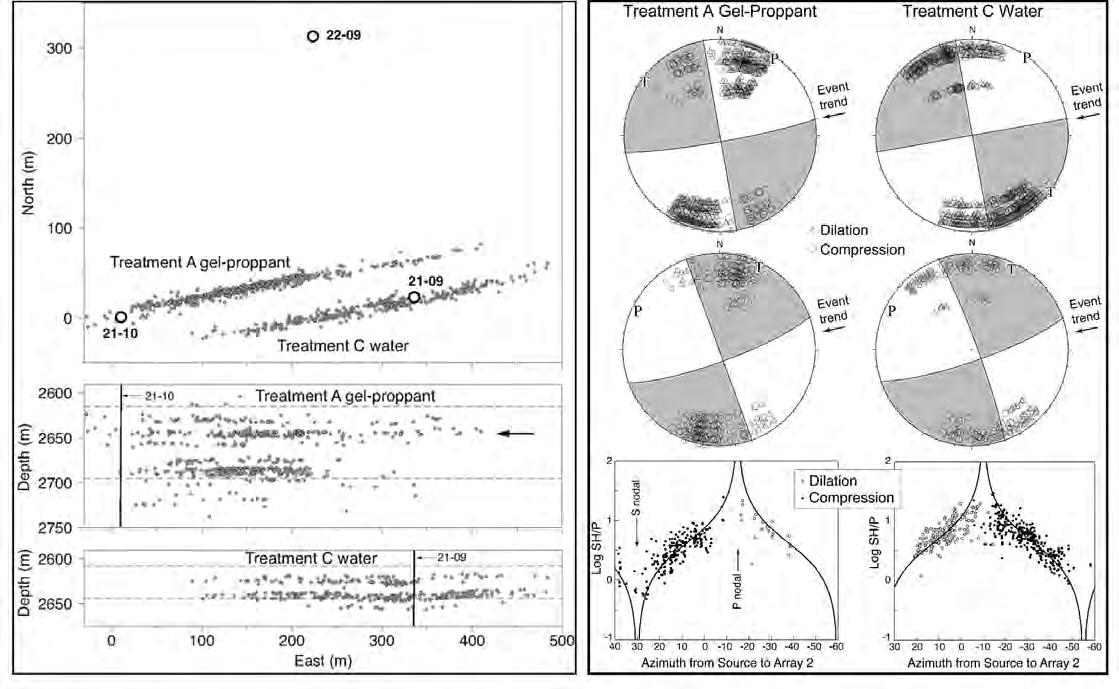
(...Continued from page 15)
and subsequent transmission to the seismic receiver, and enable analysis of the type of source: be it shear, tensile opening or closing, or explosion. While many examples show shearing, some recent studies report variable microseismic source mechanisms during hydraulic fracturing ranging from shear to tensile failures (Baig and Urbancic, 2010). The primary hydraulic fracture tensile opening mode could result in a microseismic source with a tensile mechanism, if the tensile parting results in sufficient slip in the characteristic time period of microseismic data (discussed below). If the rock is able to deform and strain under tension prior to failure, an instantaneous microseismic tensile source could occur. However, most reservoir rocks are unlikely to be sufficiently strong in tension/cohesion, to produce sufficient seismic energy to result in detectable microseismicity in a tensile failure mode. After the initial tensile failure occurs, further tensile microseismic deformation would not be expected as the rock would slowly deform due to the increase of net pressure in the fracture. Since the rock has already failed under tension, it is also relatively weak and unable to store sufficient strain for continued generation of microseismic events in the failed region. Microseismic events associated
with fracture closure are also possible from a seismologic point of view, although mechanically the phenomena is hard to rationalize, especially during a hydraulic fracture injection since the pressurized fluid that mechanically dilates fractures will also tend to resist instantaneous (i.e., microseismic source time periods) closure. A physical analogy would be trying to clap your hands together underwater.
Mechanisms may be expected to vary between monitoring projects, depending on the local pre-existing fractures and stress state along with other factors in the mechanics of the microseismic deformation. Furthermore, there are many geophysical parameters that control observed seismic amplitudes/radiation patterns, and result in uncertainties in the derived moment tensor (e.g., Šílený, 2009). Local borehole anomalies near the sensors, seismic attenuation, energy partitioning with reflection of seismic waves, multiple phases and background noise can all impact the observed amplitudes and potential confidence in the moment tensor inversion. Uncertainties in any these factors can lead to uncertainty in modeling the wave transmission part of the analysis, and thereby impact the estimated moment tensor. Furthermore, uncertainties in seismic velocity or impedance models
result in uncertainty in the transmission as well as potential accuracy of estimated source location, again leading to uncertainty in source type (e.g., kim, 2011). Finally, limitations in the angular coverage of seismic amplitude measurements due to limited number of observation wells leads to lack of uniqueness or ambiguity and an underconstrained moment tensor inversion. n ever theless, if accurately determined, microseismic moment tensor is the most complete description of the source strain and provides key information about how the rock breaks to form microseismicity.
Rutledge et al., 2004, analyzed mechanisms of microseismicity recorded during hydraulic fracturing of the Cotton Valley sands (Figure 1), and in addition to composite beachball shear-type mechanisms, modeled sh/p amplitude ratios with a strike-slip, shear model. The composite solutions assumed a single source for all events, and sampled the radiation pattern through variations in the source-receivers angles. The strikeslip shear mechanism seems plausible since the model provided a reasonable fit to the observations. note t hat these methods suffer an ambiguity between two possible slip planes orthogonal to each other, since the radiation pattern is consistent with slip on a conjugate plane. Utilizing amplitude
Figure 1. Example microseismic locations and mechanisms (from Rutledge et al., 2004).
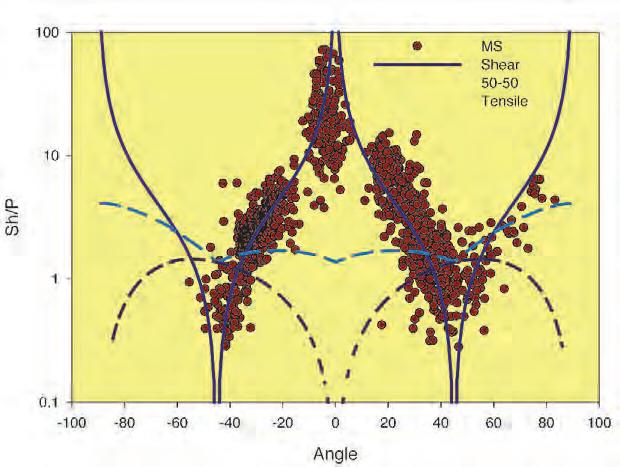
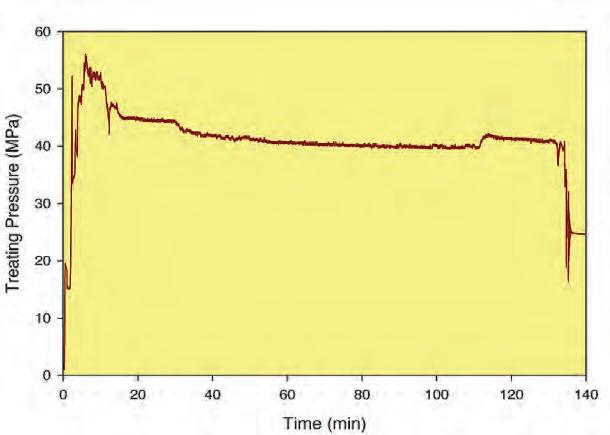
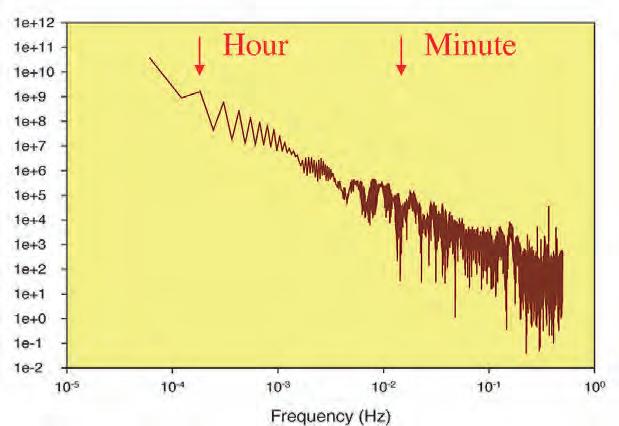
ratios is a relatively robust measurement and tends to mitigate limitations in modeling since several potential sensitivity factors tend to become normalized when common to both wave types. Figure 2 shows a similar composite mechanism plot created using data compiled from numerous events recorded in several projects, from both shale and tight gas sand fracs in different north American reservoirs. In the plot, the azimuths of the microseismic data have been normalized to the predominant azimuth of the microseismic locations to allow comparison of data from different sites. The observed amplitude ratios are well modeled by a strike-slip, shear mechanism. When there are multiple mechanisms or dip-slip failures, this same analysis does not always match as well. Also shown in the figure are the radiation pattern of a pure tensile opening mechanism along with a hybrid source of 50% strikeslip shear and 50% tensile opening. Tensile opening favours generation of compressional waves and hence results in low sh/p amplitude ratios at all angles, as does an explosional type source (pure compression, which is not shown). Only a shear mechanism is consistent with the high sh/p amplitude ratios observed at some angles, as argued in early papers (e.g., Warpinski et al., 2004).
While mechanisms can be expected to be variable, it would appear that shear is a viable and dominant mechanism for many projects. This leads to a fundamental paradox in mechanism between the potentially shear microseismic sources and the underlying tensile hydraulic fracture, which will be further discussed later.
H YDRAULIC F RAC TURE DEFORMATION
F REqUENCIES
Hydraulic fracture stimulations utilize variable injection rates and associated pressures; however, Figure 3 shows an example of what could be considered an average pressure record that is approximately uniform through the injection, and Figure 4 shows the corresponding frequency spectral content. note that the pressure is what pushes the fractures open and so is directly linked with the fracture dilation. The plot shows that most of the power is at low frequencies corresponding to time periods of more than one hour. At increasing frequency, the associated power decreases. At seismic frequencies above 1 Hz (or time periods less than one second) there is a relative power decrease of over eight orders of magnitude, relative to the lowest frequencies. Clearly the injection pressure is predominantly a slow process with most of the power that ultimately goes to fracture and eventually dilate the fractures occurring at frequencies much less than one Hz – in other words, at much lower frequency than normal seismic monitoring.
M ICROSEISMIC DEFORMATION
F REqUENCIES
As indicated above, the normal frequency bandwidth of borehole microseismic monitoring is above 1 Hz, such that low injection frequencies are outside of the recording bandwidth. Low frequencies or time
(Continued on page 18
Figure 2. Composite amplitude ratios from several projects in different reservoirs.
Figure 3. Hydraulic fracture pressure injection record.
Figure 4. Frequency spectra from Figure 3.
scales longer than one second can be recorded using broadband earthquake seismometers. Tiltmeters are also able to respond to very low frequencies and are occasionally used for hydraulic fracture monitoring, although respond to the overall fracture deformation compared to relative localized microseismic sources. Microseismic signal frequencies are typically relatively high frequencies in the range of 100’s of Hz (e.g., Figure 5). The microseismic source frequency is related to the slip time or area of seismic slip. The range of frequencies of recorded microseismic signals is also controlled by the frequency bandwidth over which the seismic sensors detect signals, generally in the 1 Hz to 1,000 Hz range (or source deformations with time scales of a few milliseconds to a second) for most borehole microseismic recording arrays. Therefore, the normal microseismic recording is in a higher frequency band and outside of the average low frequency bandwidth of the pressure that drives the hydraulic fracture dilation.
H YDR AULIC F RAC TURE
DEFORMATION E NERGY

associated with dropping approximately 1,000 railroad locomotives a height of 1 m. For this example, the microseismic locations suggested a simple, planar hydraulic fracture geometry that was calibrated with a fracture model (Maxwell et al., 2008). Based on the modeled fracture dimensions, the work done creating this fracture geometry is approximately equivalent to the total hydraulic energy of the injection, with the remainder of the injected energy attributed to fluid leak off and frictional losses.
M ICROSEISMIC DEFORMATION
E NERG Y
The e nergy or work associated with injection can be computed as the product of the injection pressure and volumes. Maxwell et al. (2008) describe several projects where the injection energy is calculated. Figure 6 shows the hydraulic energy computed for a specific case. In this example, the hydraulic energy was 50 gigajoules, or to give some physical context is approximately equivalent to the potential energy
ROCK SHOP
The r adiated seismic energy (total energy associated with microseismic events) can be computed by adding together the estimated seismic energy of individual microseismic events, or alternatively can be estimated from the cumulative seismic moment ( kanamori, 1978). Maxwell et al. (2008) describe a number of projects where the microseismic energy is compared with the hydraulic energy. In contrast to the hydraulic

energy, the microseismic energy tends to be a relatively small proportion. In the example described above, the total seismic energy was 100 J and roughly equivalent to the potential energy associated with dropping a mass of 10 kg (22 lb) the height of 1 m. Obviously in comparison with the pumped hydraulic energy, it is a relatively small portion of the total hydraulic energy. Maxwell et al. (2008) introduce a parameter termed the ‘seismic injection efficiency’ (SIE), defined as the ratio of microseismic to hydraulic energy. note that this is different from seismic efficiency defined as the ratio of seismic energy to the local energy dissipation around the seismic source. For several projects, the SIE ranges between about one part in a million to one part in a billion (e.g., Figure 6), what can only be described as a very small part of the energy balance of the hydraulic fracture. Similarly small ratios are found when comparing the slip area represented by the microseismic compared to estimates of the total hydraulic fracture area and microseismic fracture volumes with total injected volumes.
R ATIONALI z ATION OF H YDR AULIC F RAC TURE AN D M ICROSEISMIC DEFORMATION
To summarize the various aspects discussed above:
1 The hydraulic fracture is predominantly tensile opening; microseismic is often a shear-dominated mechanism.
2. The hydraulic fracture is predominantly a relatively slow process (hours), where microseismic is a relatively fast process (milliseconds).

FARHAT HYDERI,P.Geol.
3300, 205 - 5th Ave SW Calgary, AB T2P 2V7
Tel403 726 0666
Fax403 264 1262
Cell403 819 2516
farhat@sableconsultants.com
SABLECONSULTANTS.COM
Figure 5. Frequency spectra of a microseismic event.

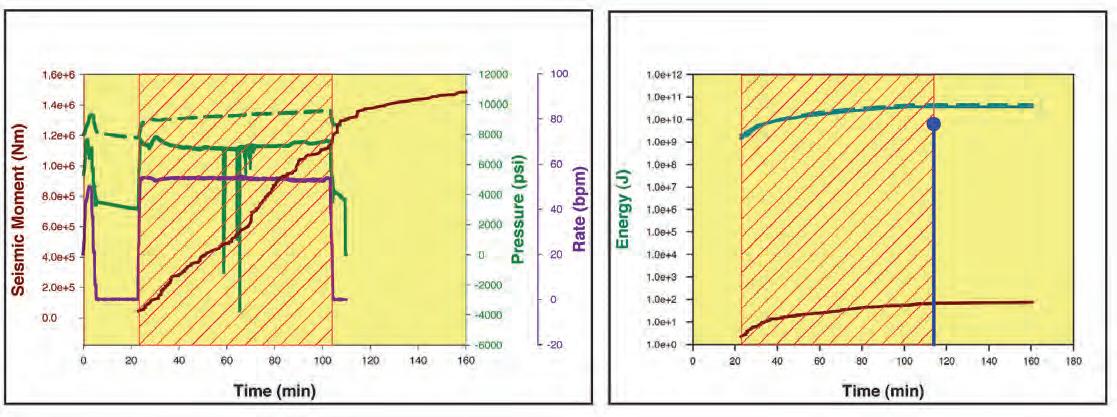
Figure 6. Record (left) of injection rate and pressure (surface solid green, calculated downhole dashed green) and cumulative microseismic moment. Record (right) of injection energy (green) and microseismic energy (red) and end of job energy from calibrated frac model (blue vertical line). After Maxwell et al. (2008).
3. The hydraulic fracture is a predominantly high-energy process, where microseismic is relatively low energy.
Therefore, there are a number of paradoxes between the modes of the hydraulic fracture and microseismic deformations, and additional deformation is occurring beyond what is manifested through the microseismicity.
An important and relevant issue is ‘aseismic’ deformation, which can be broadly defined as deformation that occurs without recording seismicity. One form of aseismic movement is microseismic signals with similar characteristics to the recorded seismicity, but with amplitudes too small to be detected. However, these smaller events would account for diminishingly small contributions to the total radiated seismic energy. More importantly, slowopening modes would also be classified as aseismic, and could have different mechanisms and source characteristics to the microseismicity. Other authors (Warpinski et al., 2004) have argued for microseismicity being localized near to, but offset from, the hydraulic fracture where the paradox described above could be explained by the microseismic representing indirect deformation triggered by a slowly dilating hydraulic fracture and associated pore pressure changes. One likely form of this is induced stress activation (e.g., Maxwell et al., 2009) where stress changes associated with hydraulic fracture strains could activate or trigger deformation of a near-by fault or fracture. In the case of critically stressed faults, even a relatively slight stress change could induce fault slip. Regardless if the microseismicity is directly or indirectly associated with the hydraulic fracture there is clearly a significant amount
of aseismic deformation in addition to the microseismic deformation.
When attempting to extract more information from the microseismic deformation is it important to remember that there is more undetected deformation occurring, and that the microseismic DOES n OT re present all the fracturing. Other modes of deformation occur that may be more directly related to the fracture effectiveness, particularly slow, aseismic tensile fracture opening and subsequent proppant placement. n eve rtheless, the relative deformation depicted by the microseismic between, for example, different regions of the reservoir can be used to verify the relative deformation estimated in a geomechanical simulation of the injection. This will be further described in the next part of this series of articles, along with a potential geology-based model of the microseismic deformation.
R EFER ENCES
Baig, A. and Urbancic, T. 2010. Microseismic moment tensors: A path to understanding frac growth. The Leading Edge, March 2010, p. 320-324.
Barton, N. 2008. The Leading Edge.
Cipolla, C.L., Williams, M.J., Weng, X, Mack, M., and Maxwell, S. 2010. Hydraulic fracture monitoring to reservoir simulation: Maximizing value. SPE133877.
Daniel, G. and White, J.W. 1980. Fundamentals of fracturing. SPE9064.
Gibowicz, S.J. and Kijko, A. 1994. An introduction to mining seismology. Academic Press.
Kanamori, H. 1978. Quantification of earthquakes. Nature, v. 271, p. 411-414.
Kim, A. 2011. Uncertainties in full waveform moment tensor inversion due to limited microseismic monitoring array geometry. SEG Expanded Abstracts.
Maxwell, S.C., Shemeta, J., Campbell, E., and Quirk. D. 2008. Seismic deformation rate monitoring. SPE116596.
Maxwell,S.C., Jones, M., Parker, R., Miong, S., Leaney, S., Dorval, D., D’Amico, D., Logel, J., Anderson, E., and Hammermaster, K. 2009. Fault activation during hydraulic fracturing. SEG Expanded Abstracts.
Rutledge, J.T., Phillips, W.S, and Mayerhofer, M.J. 2004. Faulting induced by forced fluid injection and fluid flow forced by faulting: An interpretation of hydraulic-fracture microseismicity, Carthage Cotton Valley Gas Field, Texas. Bulletin of Seismological Society of America. v. 94, no. 5, p. 1817.
Šílený J. 2009. Resolution of non-doublecouple mechanisms: Simulation of hypocenter mislocation and velocity structure mismodeling. Bulletin of the Seismological Society of America, v.99, no. 4, p. 2265-2272. doi: 10.1785/0120080335.
Smith, M.B. and Shylaporbersky, J.W. 2000. Basics of hydraulic fracturing. In: Reservoir Simulation. Economides and Nolte (ed.). Third Edition.
Warpinski, N. R., Wolhart, S.L., and Wright, C.A. 2004. Analysis and prediction of microseismicity induced by hydraulic fracturing. SPE Journal, v. 9, no. 1, p. 24.
T HE CSPG-CSEG U NIV ERSITY OUTR EACH at Vision 2012
The CSPG-CSEG University Outreach booth at Vision 2012 in May had a steady stream of students from coast to coast stop by, due in part to the foosball table, prizes, and candy. At the booth, students could sign up for CSPG and CSEG memberships and learn about the outreach initiatives that both societies offer. Of particular interest to CSPG student members were the funding opportunities available to them (Undergraduate Awards and Student Event grants) and the annual summer student field trip (to Dinosaur Provincial Park in June of this year).
Students who visited the booth had the opportunity to win several awesome prizes, including luncheon tickets, t-shirts, an iPod, a camera, and portable speakers
We couldn’t have had such a fun booth without the generous support of MacDonald Cole, who donated the furniture for the
booth, and ConocoPhillips Canada, who donated the foosball table.
A Student networking Luncheon was held on the third day of the convention. The main message from Satinder Chopra, of Arcis Corporation, was that building a successful career requires attention to the basics: working hard to do a good job and taking pride in your work. This message was reiterated by Adam West, of Devon, and Chris Podetz, of EnCana, who spoke about their own experiences in industry. The luncheon closed with a question and answer period for students.
The final student-focused activity during Vision 2012 was the Student Mixer, held at the Below Deck Tavern on Stephen Ave immediately following the Challenge Bowl. Over 100 students registered to attend this year’s mixer. The crowd was nicely rounded out with a good showing from
professional members of the CSPG and the CSEG. Food and refreshments were on hand while the attendees mixed and mingled.
If you’re a student looking for an opportunity to learn about the fascinating advances taking place in industry, to hone your networking skills, and to form new friendships, then don’t miss GeoConvention next year!
The student-focused activities at Vision 2012 would not have been possible without the volunteers. Thank you to the CSPG and CSEG members who volunteered to greet students at the booth, and for providing such a strong industry presence at the Challenge Bowl and Student Mixer. The opportunity to interact with more experienced professionals that these activities afford, and that volunteers make possible, are invaluable to students.
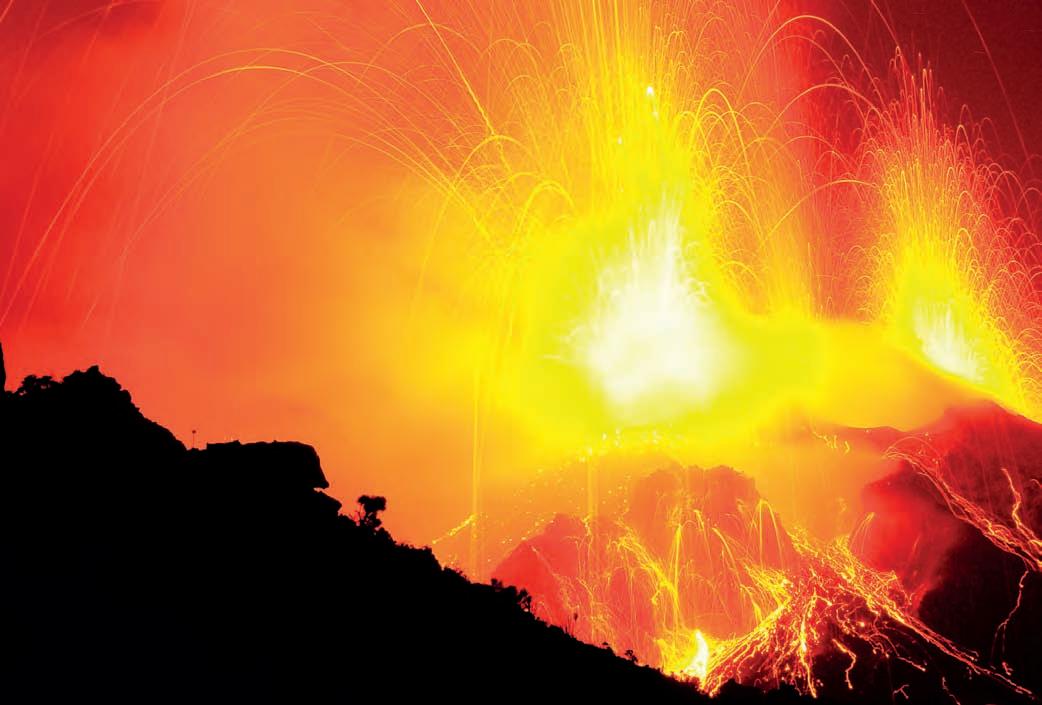
CALL FOR PHOTOS 2013 CSPG C ALE NDAR
$
a ny la ndscape-oriented photo of geological interest, Canadian or international content.
Please include a brief description and location.
m aximum of 3 entries per person.
Digital photos only
(Ti FF or high quality JPe G wit h minimum resolution of 3m P)
To s ubmit photos, please send to markus.ebner@bonavistaenergy.com, caitlin.young@cspg.org
PHOTO OF TH E MONTH
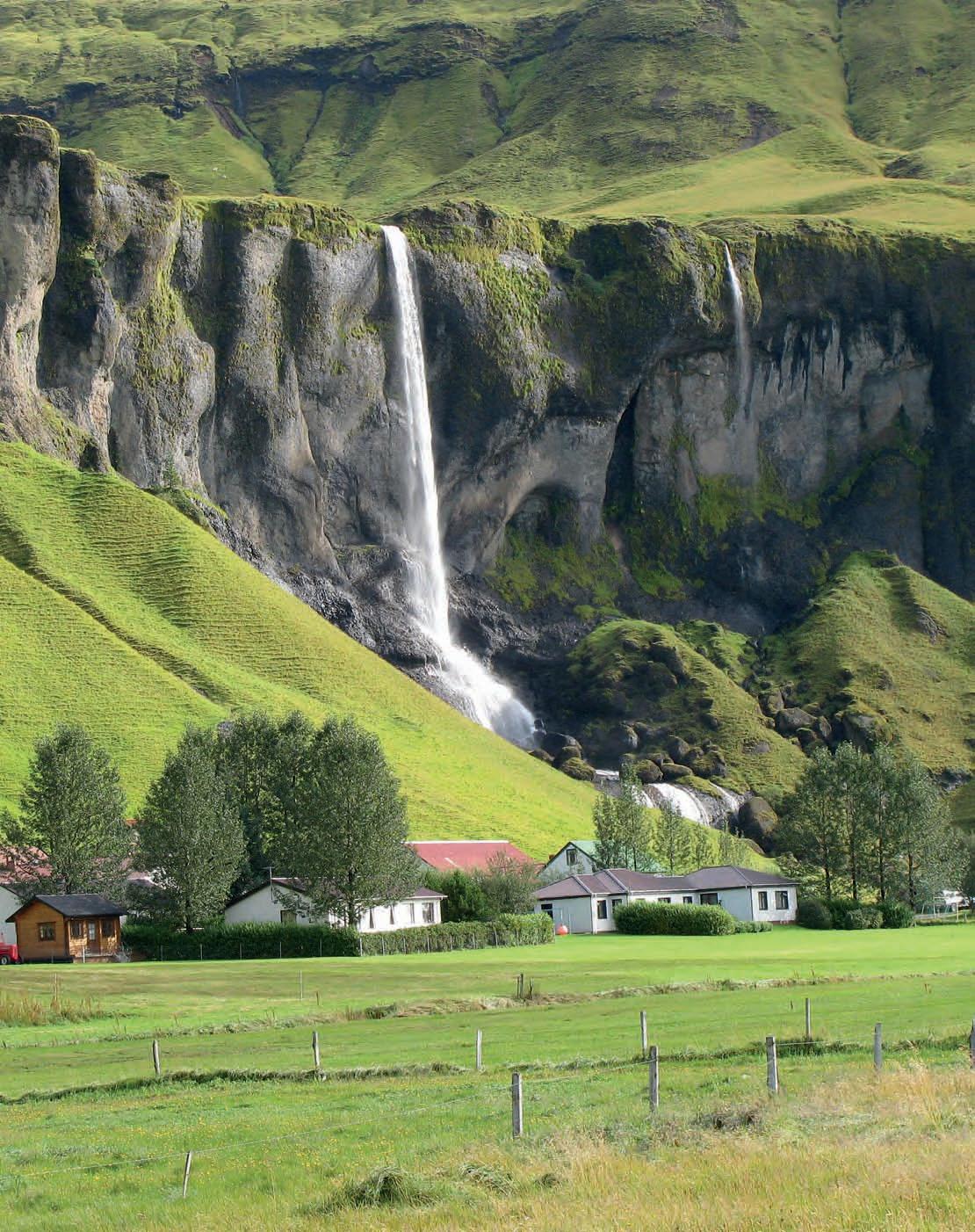
Waterfall in southeast Iceland. Photo by Nicole Williamson.
Theme: In the Kitchen: Focus on Liquids-prone
Source Rock Reservoirs
Five Great Days of the Finest Geoscience Training for One Low Price
Courses will include:
• Fracture Characterization and Evaluation For Unconventional Resources
• Risk, Uncertainty & Decision-Making in Unconventional Resource Plays
• Exploration in the Bakken Petroleum System
• My Source is Now My Reservoir
• Understanding Heterogeneity in US Shale Plays
• Applications of Micro-Seismic to Fine-grained Petroleum Systems
• Nuclear Magnetic Resonance in Unconventional Resources
• The Application of Geomechanical Data and Modeling to Developing Shale Reservoirs
• Introductory Geochemistry for Condensate-rich Shales and Tight Oil
• Log Analysis of Shaly Sands
• Geosteering for Geologists
(Three
Hosted by the Norris Conference Center 803 Town & Country Lane
Houston, TX 77024
Phone: 713-590-0950
Fax: 713-590-0961
Special AAPG Group Rates at Nearby Hotels!
Registration and information:
Toll-free (U.S. and Canada)
888-338-3387, or 918-560-2650
Fax: 918-560-2678
E-mail: educate@aapg.org
Download a registration form at: www.aapg.org/education/fec.cfm
(Your
ON THE USE AN D A BUSE OF I NDUSTRIAL I NTELLIGENCE –A Cautionary Tale
| By Tom Sneddon, Manager of Geoscience Affairs, APEGA
We have all done it. In fact, it is a critical strategic planning function. “It” is the collection, collation and interpretation of industrial intelligence information, a.k.a. Field Scouting. Geoscientists are in the forefront of the wealth-creation process. We advise business leaders (many of whom are also geoscience professionals) on where the valuable resources are and how to extract them. This is what business plans in the resource industries are all about.
Before we can build a sound business plan, we must have a sound strategy. It is a tautology that unless we know where we are going, how do we know when we have arrived? The strategy must define what we hope to achieve and provide an outline of the intermediate goals required to get there. It must also possess the moral and ethical values that will inspire all those affected by it to embrace it. The strategy
must not only show the way, it must be the right way.
People who are cynical about the ability of corporations to behave morally and ethically certainly have a lot of bad examples from recent history to point to. Much of our current financial turmoil, it could be argued, came about because of suspect leadership in the front office of some multinational corporations, a number of which crashed like Shelly’s mythical statue of Ozmandias. “Look upon my works, ye mighty, and despair!” said the inscription. not. Corporate strategies that are hijacked for personal enrichment are obviously a bad idea. Even the mythical Gordon Gekko, as played by Michael Douglas in the “Wall Street” movies, has recanted the “I believe in greed” speech (http://www.marketwatch. com/story/gekko-recants-now-greed-is-nogood-2012-02-28).

A sound strategy needs a deep well of information on the shape of the marketplace, and in particular, about whom else occupies the target market space. Thanks to the internet and securities law disclosure rules, data on public and quasi-public corporations are readily available, although by the time it becomes public information it tends to be somewhat stale news. Privately held companies that do not access capital markets may disclose nothing publicly at all. The temptation is great to find out clandestinely what the opposition is up to.
n ation states are the experts in covert data collection. In The Art of War, Sun Tzu devoted an entire chapter to “Employment of Secret Agents”. In the oil and gas business, the manifestation of industrial intelligence is the Field Scout. Field Scouting methods are anything but
(Continued on page 24...)

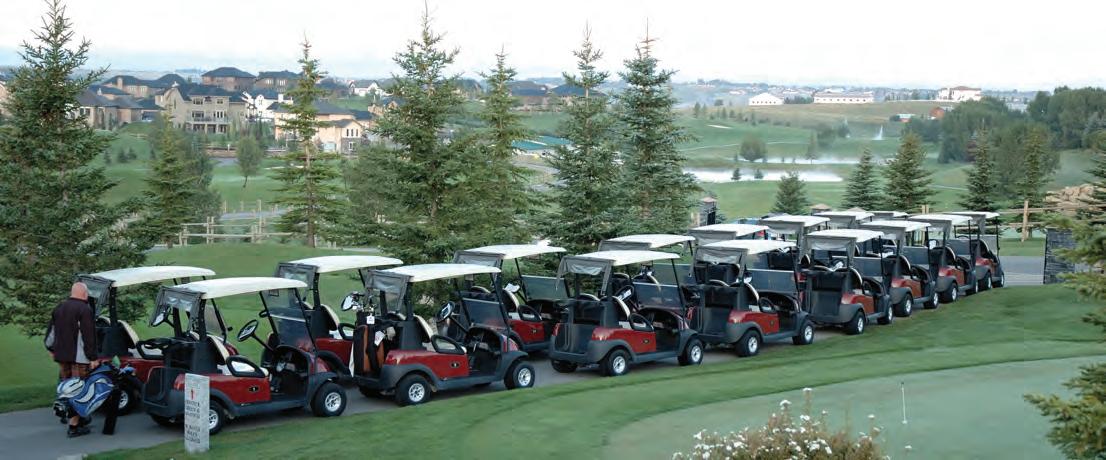
clandestine, despite the colourful history of industrial espionage engaged in by early practitioners. The days of hunkering down just outside of a tight-hole lease with night glasses and a notebook counting drillpipe stands and truckloads of mud have gone the way of Ol’ Paint and have been replaced by satellite and aerial imagery. Still, rumour has it that there are some freelancers out there who simply traded Ol’ Paint for computers and communications hacking to get otherwise unavailable information. Dangerous ground indeed.
not knowing much about the current state of play, your humble scribe got in contact with the doyenne of oilfield scouting, Terry Strang of Canadian Oil Scouts Association fame. I am assured by the cognoscenti in the oil and gas business that Terry knows more about this aspect of exploration and
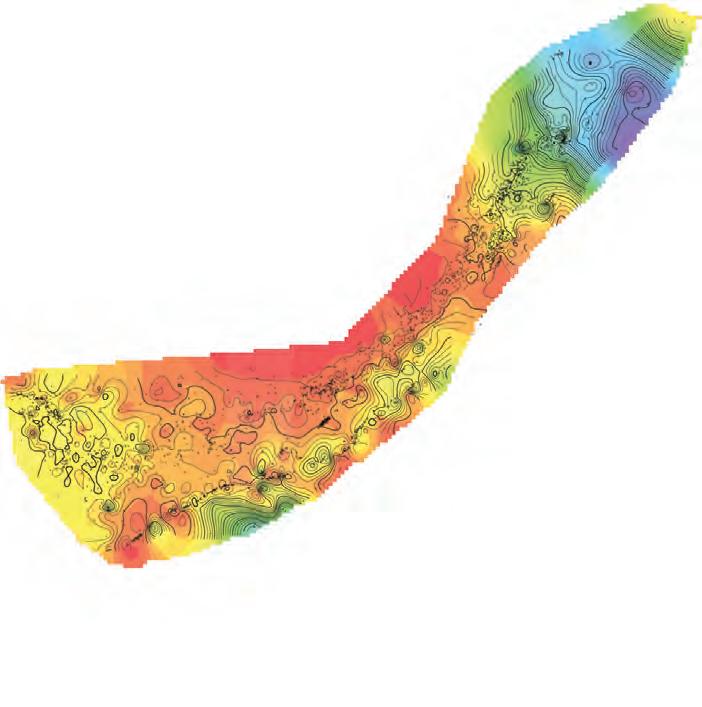
TIMEWELLSPENT
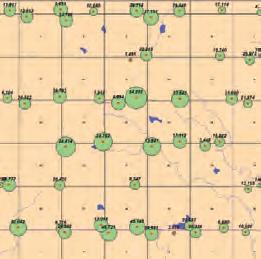
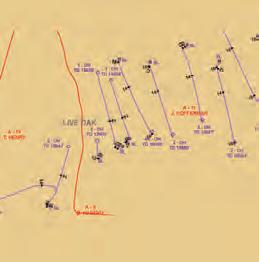
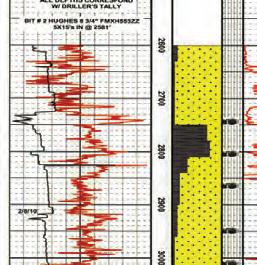
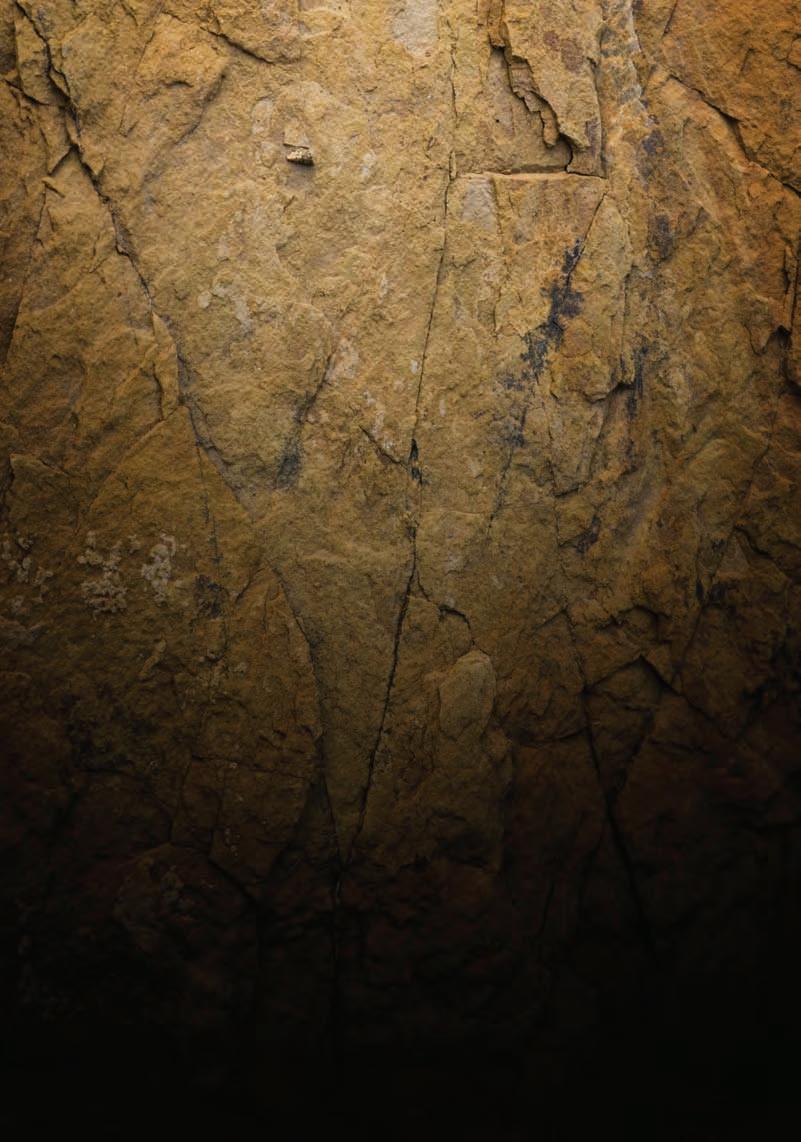
for majors and public companies, it is critical to have ethical guidelines for your scouting representatives, as a company’s reputation could be severely damaged by using a scouting contractor that uses illegal means. Although there is that fine line in the courts, much of the scouting activities are still considered in the grey zone. With the daily advances in technology, it is tougher and tougher for espionage to occur as it did in the past, and easier for competitors to maintain tight-hole status at the wellsite.
Due to the difficulty of getting information over the airwaves as was done in the past, some scouts may resort to unethical measures like trespassing onto the lease, B&E, and so on. Part of her company’s procedures was to tell the field scouts that they were not to use their scanners to obtain information, and everything had to be visual to ensure that no laws were broken.
Early in her 34-year career, she established a separate version of ethical guidelines, in addition to the corporation’s, for her field consultants to protect her company against any activities that may be considered illegal. Some of those grey clouds never leave and linger on. Even though most new professionals are unaware of the scouting profession, it seems like every one knows of past transgressions.
It is important to gain knowledge for strategic planning in many aspects of drilling, completions, production, environmental concerns, land strategies, positioning, and competitor analysis. In addition to E&P companies using scouts, many financial firms and marketing companies also use field scouting firms to help analyze a new play and keep their clients up-to-date with the most current information.
The Canadian Oil Scouts Association used to be the best source for current and accurate data. Unfortunately the professional scout in Canada has gone the way of the dinosaur, thus, increasing the activities of Field Scouting. The association is still in existence but unfortunately is not providing the competitive advantage it did in the past due to the lack of professional scouts that have either retired, or moved on to new careers. Data acquired from Field Scouting services has to be used carefully to ensure confidentiality. The information may not be 100% correct, but it gives the company the competitive advantage in evaluation of a prospect and helps to determine if the play is commercially viable.
and should not be exchanged as part of a well trade. It is the operator’s choice to share this information with their partners or to keep it confidential if their partners were not involved in the payment for this program. Internally, this data should always be recognized in presentations as containing field scouting data along with internal professional analysis.
Currently around the world, scouting is considered a very valuable activity for several companies, and organized meetings are held in almost every country. In Calgary, a group called the Calgary Global Exploration Forum started up over a year ago. There are about 30 international companies that meet to discuss their activities on a regular basis and many of the representatives are top management that gently refer to this as an international scout group. To see web links to some of the organized groups around the world visit www.oilscouts.com the international oil scouts website. There are numerous groups not listed yet, but we are aware of them holding formal scout meetings in, for example: Trinidad, Spain, Italy, Colombia and nigeria.
Canada is currently the only country I know of that has the Field Scouting profession in their industry. I am aware of other countries that allow their internal scouts to go to the field and gauge the activity in the interested areas as well as try to determine the status of wells that are currently active.
Like many aspects of professional geoscience work, quality control of data is an absolutely essential duty. One aspect of quality control is chain of custody and of ownership of data and information, including field scouting information, as Terry suggests above. Just because a report or map or seismic section is in company files doesn’t mean it can be used. It may be there following some clandestine act and never was properly disposed of, or it may be something less dramatic like a farm-in agreement for a single use at a single location and may not be used for any other purpose, including yours.
Industrial intelligence, including field scouting, is an essential activity. It must be performed in a manner consistent with the APEGA Code of Ethics and all sources must be identified in your files. Do you know where your scouts are tonight?

The Techlog* wellbore software platform enables you to capitalize on your data investment—improving planning and formation evaluation— in every well. The new acoustics and geomechanics, and enhanced mineral solver capabilities provide powerful additional science, while the redesigned and highly customizable interface promotes knowledge sharing and increases productivity.
Techlog software delivers optimal data integration for better decisions—from exploration to production.
For details call (403) 294 4300
www.slb.com/techlogpetrophysics
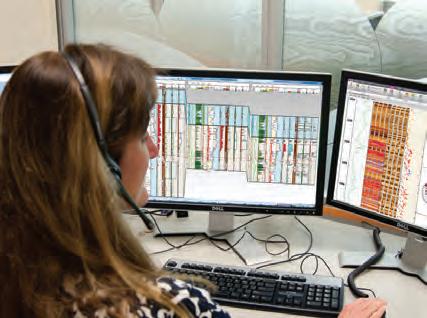
GO TAKE A HIKE Moose Creek, near Golden, BC
| By Philip Benham, Thomas Mumford, and Yingchun Guan
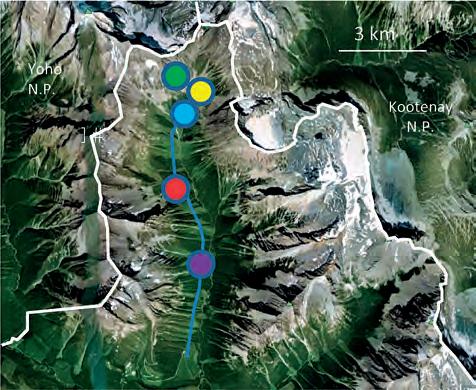
references: Currie, K.L. 1975. GSC Bull 245. Gussow, W.C. 1977. BCPG, v. 25, no. 3, p. 505-517. Price, R. A., Mountjoy, E. W., Cook, D. G. 1978. Mount Goodsir, West Half. GSC Map 1477A.
Mumford, T. R. 2009. Dykes of the Moose Creek Valley, Ice River Alkaline Complex, southeastern BC. UNB M.Sc. thesis.
The Reservoir Committee welcomes contributions from our readership to this series. If you wish to offer a submission to Go Take a Hike on your favourite hike of geological interest, email the Reservoir at caitlin.young@ cspg.org for more information.
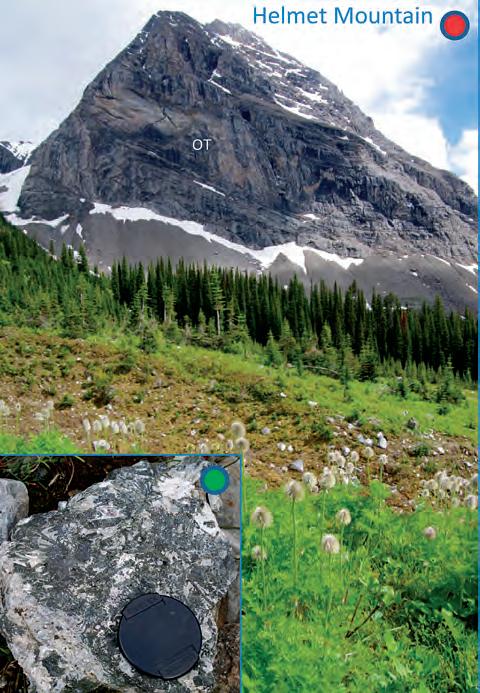
trailhead: Few have visited this remote location, which should only be attempted with an experienced guide (best done on horseback). Therefore specific instructions for location are not provided. Beaverfoot Lodge (which is 26 km west of Field, BC on Hwy 1 and 14 km south on Beaverfoot Road) is the logical base as it is close to the trailhead – accessed via logging roads. To arrange or join in a horse ride to the site contact Burgess Shale Geoscience Foundation (1-250-343-6006) or Beaverfoot Lodge (www.beaverfootlodge.com).
distance: The entire trail (marked in blue) is about 25 km return. Even on horse it is a challenge. Be prepared for nine hours on horseback, numerous stream crossings, and some narrow and steep trails through forest, beautiful meadow, avalanche tracks, and bare rock. From the end of the horse trail you can spend an hour or so scrambling about the cirque looking at the rubble. A more serious effort of a few hours would be required to examine outcrops. Dress for mountain weather conditions.
The Ice River Alkaline Complex (IRAC) takes on almost mythical proportions for its complexity, unusual minerals, remoteness and surroundings of glacier-clad and sculpted peaks. The 18 km-long IRAC is the largest intrusive igneous package in the Rockies. The host rocks of this alkaline ultramafic intrusive include the mid-Cambrian to lower Ordovician strata of the Chancellor and Ottertail formations and Mackay Group. The metamorphosed contact between the igneous and sedimentary strata consists of skarns (recrystallized limestones forming sacharroidal marble with pyroxenes and epidote) and hornfels (pyroxene, quartz, feldspar). The age and genesis of the complex are only now being understood, long after G.M. Dawson first described it in 1886. As recently as 1977, Gussow proposed the IRAC was a remnant of Precambrian basement because he felt the skarn was actually a conglomerate marking the base of the Cambrian strata.
The IRAC consists of multiple phases all emplaced around 360 Ma (the Devonian-Carboniferous boundary). The oldest phase is a rhythmically layered mafic complex comprising of nepheline- and pyroxene-rich rocks (with unpronounceable names such as jacupirangite, ijolite, and urtite) plugged with carbonatite (an unusual igneous rock that is rich in carbonate instead of silica). The next event in the complex is the emplacement of a cross-cutting nepheline syenite body followed by sodalite syenite dikes, and the entire complex is cross-cut by lamprophyre dikes (Currie, 1975). A final phase of carbonatite dikes occurred around 165 Ma (mid-Jurassic) (Mumford, 2009). The mantle nature of the complex and the periodic emplacement of intrusions suggests some structural weakness in the crust in an otherwise tectonicly quiescent location. The story is further complicated in the late Cretaceous to Paleocene when the entire package was thrust up to 200 km east, deformed, and mildly metamorphosed during the Laramide Orogeny.
The lands are under mineral claim by Eagle Plains Resources who are interested in the lead, zinc, iron, gold mineral deposits, rare-earth elements and metals (Niobium, Zirconium, and Hafnium), as well as ceramic-grade feldspar and nepheline in the syenites, semi-precious gemstones (such as sodalite), and ornamental stone. Steep slopes that you cross on horseback have abundant avalanche tracks. Note the deformed trees, jagged stumps, and jumble stacks of fresh logs – all a testament of the force of the avalanches.

For most of the trail the dolomites and limestones of the cliff-forming Ottertail Formation are underfoot. Near the end of the trail at Zinc Mountain, (Z on map) the western slopes contain a thick sheet of sulphides at the base of a lamprophyre sill within the Ottertail. Pyrrhotite, pyrite, sphalerite, and galena are common in the sulphide zone and the Ottertail is altered to a skarn with coarsely crystalline white calcite.
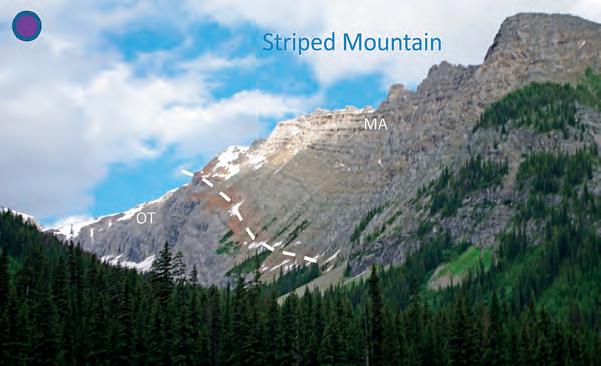
Photo
Dark green amphibole lathes up to 5 cm long.
Mildly deformed carbonates of the Ottertail Formation (OT) and thinly bedded shales and carbonates of the 2 km-thick Mackay Group (MA) along Moose Creek. The strata are respectively the distal equivalents of the platformal Lyell Formation and the Bison Creek-Mistaya-Survey Peak formations to the east.

Sphalerite, pyrrhotite, and biotite in hornfelsed clasts of the host sediments floating within the intrusive complex. The white veins are cancrinite.
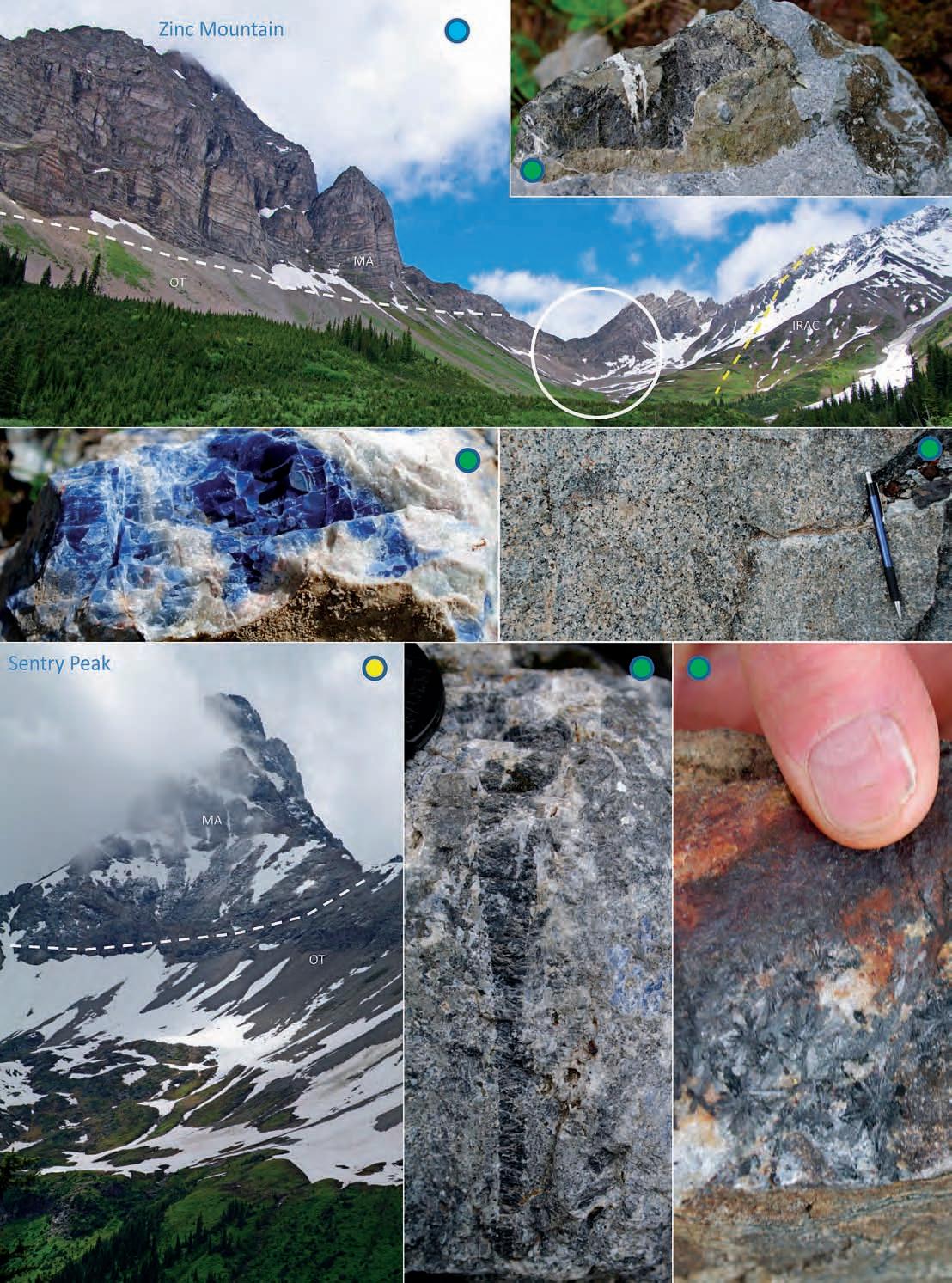
View of valley towards end of the horse trail looking north. To the right are rocks of the layered mafic units of the Ice River Alkaline Complex. The Mackay Group is cross-cut by numerous small faults. To the centre (circled) and right are the talus-covered slopes containing mixed talus from the host sediments, urtite-dominated intrusives and the contact skarn. The dashed yellow line marks the approximate edge of the intrusive complex.
Rich blue sodalite is one of the more spectacular minerals of the Ice River Complex. It is primarily found in veins but is also hosted within the sedimentary and igneous rocks.
Coarse-grained Nepheline Syenite
Sentry Peak, composed of Ottertail and McKay fms, seen from the end of the horse trail.
Unusual lathes of aegirine over 10cm long with patches of sodalite (blue) and nepheline (grey).
Dark grey radial acicular clusters of amphibole.
All ages welcome
Adults: $20 ($25 at door)
students: $10 ($15 at door)
Children (12 & under): free For groups of 10 or more please contact the CSPG office at (403) 264-5610 | www.cspg.org
From Evolution to Exploration Our African Journey
2012 HONORARY ADDRESS
Monday Nov. 26 2012
Southern Alberta Jubilee Auditorium, Calgary AB Doors 6:00 pm | Talks 7:00 pm
SPEAKERS
Ian Tattersall – Curator Emeritus, Biological Anthropology American Museum of Natural History, New York
Dr. Trent Rehill – VP Geosciences, Kulczyk Oil Ventures
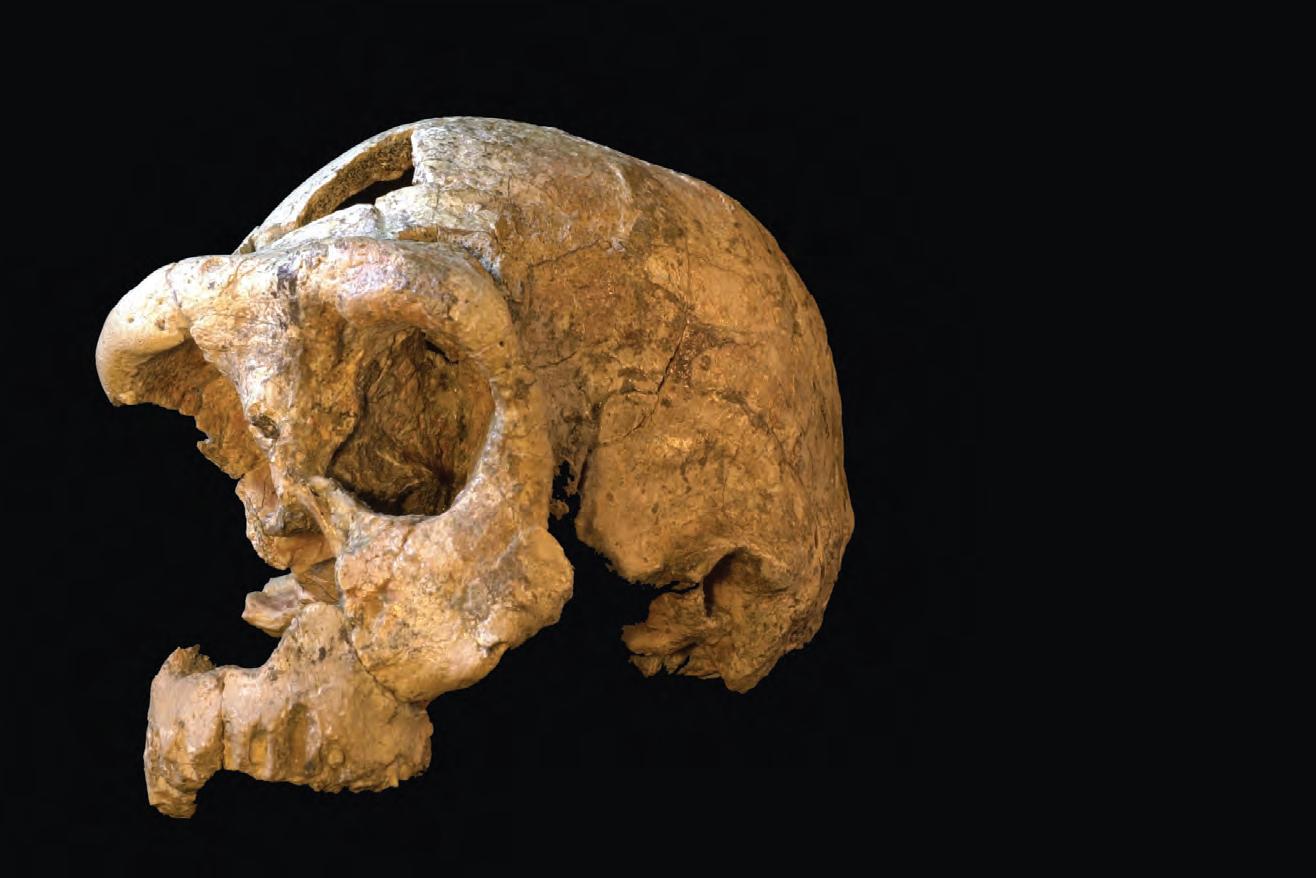

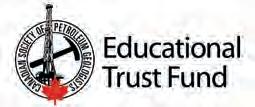

2012 CSPG AwARDS C ERE MONY
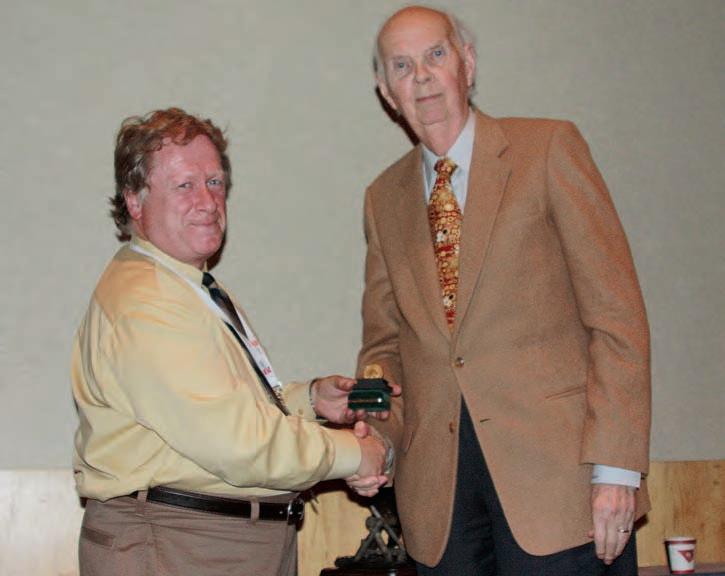
The Canadian Society of Petroleum Geologists annually recognizes members for their dedicated volunteerism and technical contribution to advances in Petroleum Geology.
The 2012 Awards Ceremony was held during GeoConvention: Vision 2012. The 2011 CSPG Award recipients, Award Committee Chairs, various members of the CSPG Executive Committee, and guests met at the Calgary Telus Convention Centre to celebrate these achievements.
Master of Ceremonies was CSPG President Robin Mann and to help him hand out the awards were Service Directors Michelle Hawke and Mike Seifert as well as Volunteer Management committee Chair Martin Teitz. Award committee Chairs kirk Osadetz (President’s Award), Ian kirkland (Medal of Merit), Lloyd Freeman (Link Award), Margot McMechan (R.J.W. Douglas Medal), Mike Rogers (H.M. Hunter Award), and Clint Tippett (Stanley Slipper Gold Medal) were on hand to present their respective awards.
A variety of volunteer and technical awards were presented throughout the evening including the following:
Stanley Slipper Gold medal for Outstanding Career Contributions to Oil and Gas Exploration in Canada – Ned Gilbert.
r .J.W. Douglas m eda l for Outstanding Contributions to the Understanding of Sedimentary Geology in Canada – Darrel Long.
Honorary m embership – Gerry Reinson and Roger Walker were acknowledged and presented with their awards the following evening at the 12th Annual Long-time Members Reception.
Link award for Best Presentation –Technical Luncheon Series – Stephen Grasby.
m eda l of m erit for Best Paper Related to Canadian Petroleum Geology – Tim McCullagh and Bruce Hart.
President’s award for Outstanding Service by a CSPG Member – Paul MacKay.
H. m . Hunter award for Distinguished Service to the Society – Timothy Bird and Graeme Bloy.
Tracks awards for Members Who Have Set new St andards of Excellence – David Garner, Greg Lynch, Dennis Meloche, Trent Rehill, and Bob Potter.
Partnership Tracks award for nonCSPG members or non- Geologists who Have Made Outstanding Contributions to CSPG – Rob McGrory.
Service award s – 103 recipients (a list of recipients can be seen at www.cspg.org).
volunteer award s – 80 recipients (a list of recipients can be seen at www.cspg.org).
Congratulations to all of the 2011 award winners and a big THAnk YOU goes out to all of CSPG’s volunteers and contributors – the Society exists because of your volunteerism.
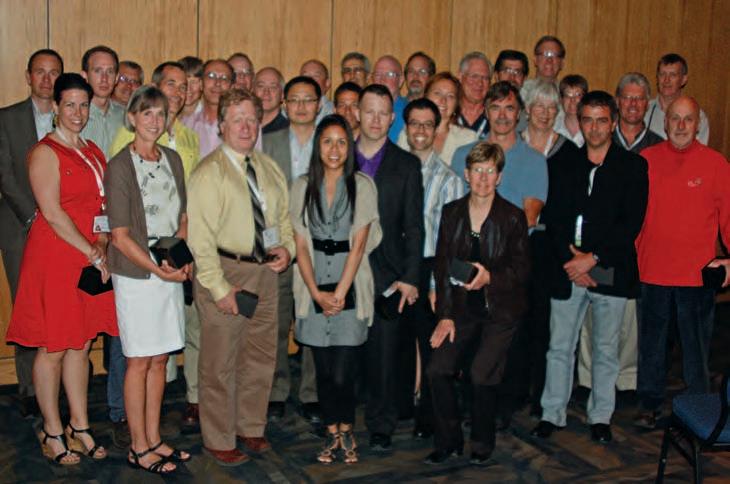
Service Award recipients.
Clint Tippett (L) presenting Ned Gilbert (R) with the Stanley Slipper Gold Medal.
2011 H.M. H UNT ER AwARD
The CSPG H.M. Hunter Award was created to recognize individuals who have served the Society in a variety of capacities over many years. It is named in honour of Harry M. Hunter, the Society’s 12th President, who served in 1939. The 2011 recipients of the H.M Hunter Award are Tim Bird and Graeme Bloy. The award was presented at the 2012 CSPG Awards Reception on Tuesday, May 15th at the Calgary Telus Convention Centre.
T IMOTHY BIRD
Tim has been a member of the CSPG since 1979 and has contributed significantly to its welfare through numerous assignments over the years.
The most significant contributions have been as a member of the Honorary Address committee for ten years (1996 to 2005), as Director of the Educational Trust Fund for five years and as Chairman or cochairman of the Advertising Committee for eight years. Along with these duties he contributed to the Reservoir committee raising funds for publishing and helped invent the colour, large-format, print Reservoir, helping to bring digital products to our members.
In addition to these challenging roles Tim volunteered on several Convention committees (including Core conferences) as well as the CSPG/APEGGA University of Calgary Student Liaison committee, encouraging many new members to join the CSPG. He has taken on numerous other assignments that are not fully recorded in the Society’s register of volunteers.
GRAE ME BLOY
Graeme has been a member of the Society since 1977 and has contributed in numerous ways over this long period. Most recently he spent a three-year term on the Executive committee as Vice President, President, and Past President. During his tenure, the Society flourished with numerous educational activities, several conventions, and a full range of member services. During his year as Past President he was a member of the Compensation and Benefits Committee.
Prior to his term on the Executive, Graeme’s most notable service was as Chairman of the Educational Trust Fund (ETF) for four years. This involved bringing the ETF into financial accountability, streamlining the investment portfolio, and managing the financial funding of most outreach functions
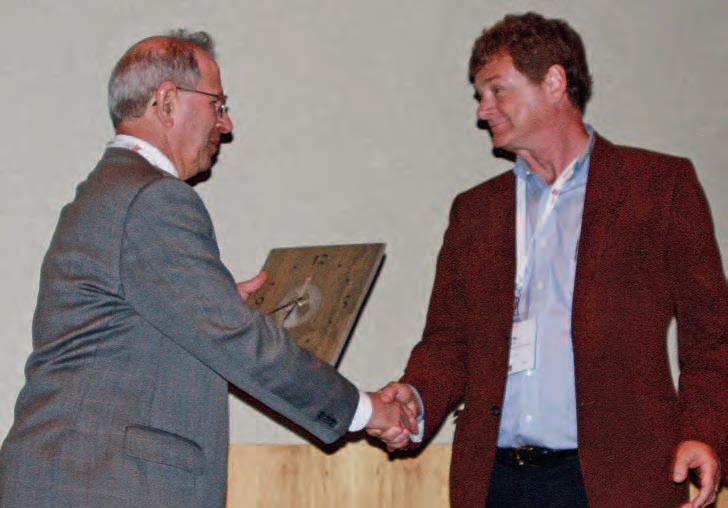
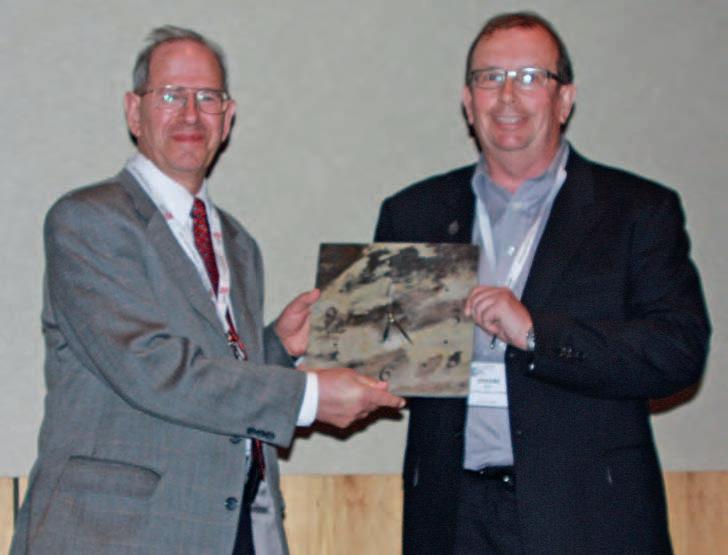
in the Society such as SIFT, the Honorary Address, initiation of student chapters, etc. This highly important role is one of the most onerous because of the legal requirements of an independent Trust – a separate entity from the Society proper.
Through the years Graeme has stepped up in a number of educational roles and was also responsible for the Manpower Survey for six years in the mid 1980s. In the ‘80s
through to 2005 he organized and chaired several themed short courses concerning carbonate deposition and diagenesis. He also ran numerous field seminars with co-leaders on carbonate deposition and reservoir characterization and fractured carbonate reservoirs.
Today, Graeme continues to serve the Society as a member of the Membership Committee.
H.M. Hunter award Chair Mike Rogers (L) presenting Tim Bird (R) with his award.
H.M. Hunter award Chair Mike Rogers (L) presenting Graeme Bloy (R) with his award.
2011 HONORARY M EMBERSHIP AwARD
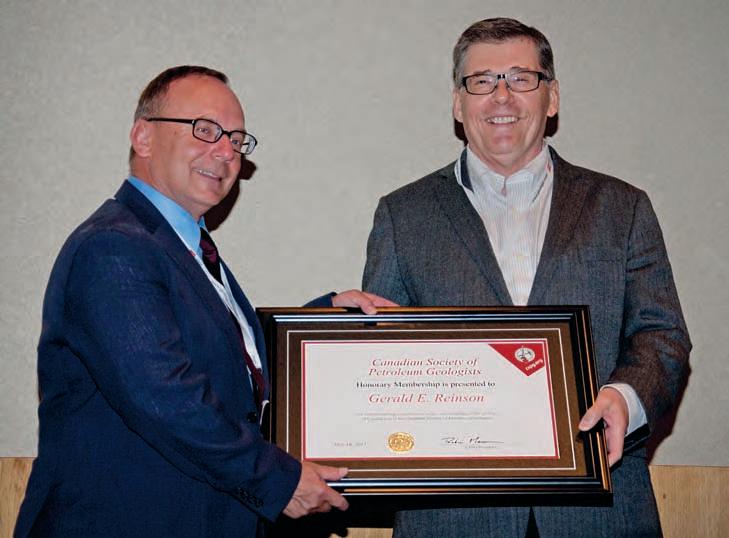
Honorary Memberships are awarded for distinguished service to the Canadian Society of Petroleum Geologists. This year two worthy recipients were presented with their awards at the 12th Annual CSPG Long-time Members Reception on Wednesday, May 16, 2012 at the Calgary Telus Convention Centre.
GERA LD E. R EIN SON
Ger ry Reinson has over forty years experience in the related disciplines of petroleum geology, marine geology, and environmental geology, having worked in both the public and private sectors as a research scientist, manager, and petroleum explorationist. Through all of these experiences he has dedicated significant time and effort to the activities of CSPG.
Influenced by his mentors n orm Fischbuch and n orm Wardlaw, Gerry joined CSPG as a student member in 1967. His volunteer service to the Society started in the early 1970s and continues today. Gerry’s earliest contributions focussed on core conference committees and field trips. Subsequent committee service included various award committees, the Education Advisory Committee, the n ational Liaison Committee, and CSPG representative to the Canadian Geoscience Council. He has also been a member of several annual conference organizing committees, most recently chairing the 75th Diamond Jubilee Conference (2002) and co-chairing the
Gussow Conference in 2007. Most notably, Gerry has provided strong leadership to the Society through his tenure as VicePresident, President, and Past President from 1995 to 1997.
Gerry has contributed substantially to furthering the technical knowledge of our members though his service as Associate Editor of the Bulletin of Canadian Petroleum Geology and his chairing and editing of two core conference publications. Gerry has published extensively. He regularly conducts field and laboratory courses as well as technical seminars to industry and has presented numerous oral, poster, and core presentations at CSPG-sponsored events. Gerry has also been a major contributor to CSPG Bulletins and Memoirs and to the Geological Atlas of the Western Canada Sedimentary Basin. Gerry’s work on the Cretaceous of the WCSB has been a guiding light for many explorationists.
ROGE R G. wA LKER
The CSPG is pleased to bestow Honorary Membership on Roger Walker, recognizing his work in teaching and research, particularly in the Western Canada Sedimentary Basin. He has had an outstanding career as a researcher and teacher with enormous contributions to sedimentary geology.
His research in the early years was concerned with turbidites, particularly in
q uebec. In 1975 he discovered the wideopen possibilities of working in the Western Interior Seaway, initially in outcrop and then increasingly in the subsurface.
Roger and his many students became fixtures in the Core Research Centre, contributing particularly to the Cardium, Viking, and Dunvegan, among many other units. During his teaching career Roger supervised 48 M.Sc. and Ph.D. students, and five Postdoctoral Fellows. This work led to
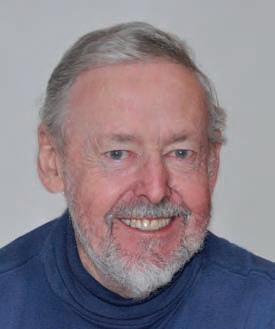
approximately 150 publications as well as many sets of short course notes and field guides. At the invitation of the Geological Association of Canada, Roger (along with n oel James) edited three editions of “Facies Models,” which has become GAC’s best-selling publication. He has given or contributed to 89 short courses in seven different countries and has been invited to give lecture tours in Canada, the USA, Australia, n ew Ze aland, Poland, and Hungary. He was also the “Judd A. and Cynthia S. Oualline Centennial Lecturer” at the University of Texas, Austin and is particularly pleased to have received a Faculty Finalist’s Certificate and Certificate of Excellence from the McMaster Student’s Union for his undergraduate teaching.
Past President Kirk Osadetz (L) presenting Gerry Reinson (R) with the Honorary Membership award.
Roger Walker

The R.J.W. Douglas Medal is presented annually for outstanding contributions to the understanding of sedimentary geology in Canada and includes the related fields of regional tectonics, petroleum systems, and structural geology. The award is open to all geologists who follow the example of R.J.W. (Bob) Douglas in contributing to the development of Canadian sedimentary, petroleum, and structural geology.
The R.J.W. Douglas Medal Award Committee is pleased to present Darrel Long as the recipient of the 2011 award. Darrel received his award at the 2012 CSPG Awards Ceremony on Tuesday, May 15 at the Calgary Telus Convention Centre.
Over his career Darrel Long has made an outstanding contribution to understanding a wide variety of sedimentary deposits across a huge roster of sedimentary basins in Canada and beyond. Until now he has produced 84 peer-reviewed journal articles, 44 peer-reviewed articles in government publications, 136 conference abstracts, as well as several field trip guidebooks and a CD on sedimentary structures. This is a very strong, multi-disciplinary publication record, especially for someone who is a fulltime teaching professor at a relatively small university. Among these achievements, Darrel is an acknowledged international leader in Precambrian fluvial systems. His regional approach is especially in keeping with the spirit of the Douglas Medal.
Darrel is currently engaged in both the small- and large-scale architectural analysis
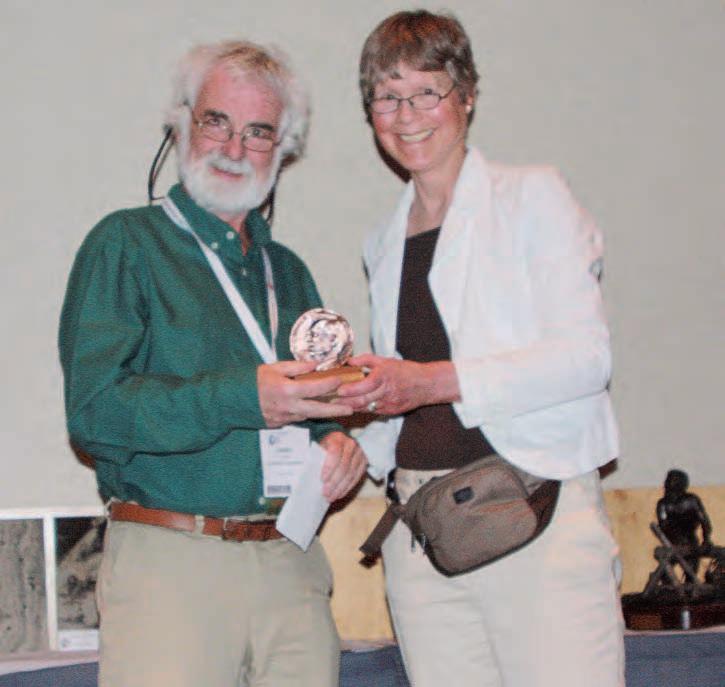
of fluvial strata and hopes to link this to a better understanding of paleoclimates and paleohydraulics as an essential component of basin analysis. He was a major participant in the Geological Survey of Canada’s recent E x TECH program on fluvial deposits of the Athabasca Basin which has stimulated a
great deal of uranium exploration activity.
The full citation for the 2011 R.J.W. Douglas Medal can be seen in the March 2012 issue of the Bulletin of Canadian Petroleum Geology.


R.J.W. Douglas Medal award Chair Margot McMechan (R) presenting Darrel Long (L) with his award.
ROCK SHOP



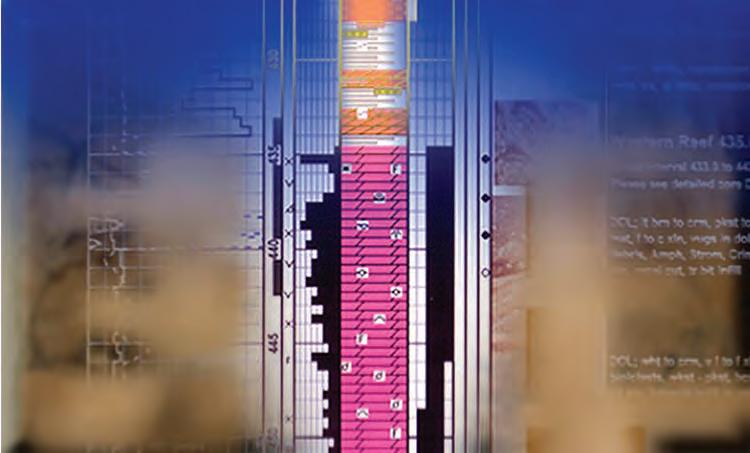





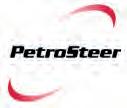
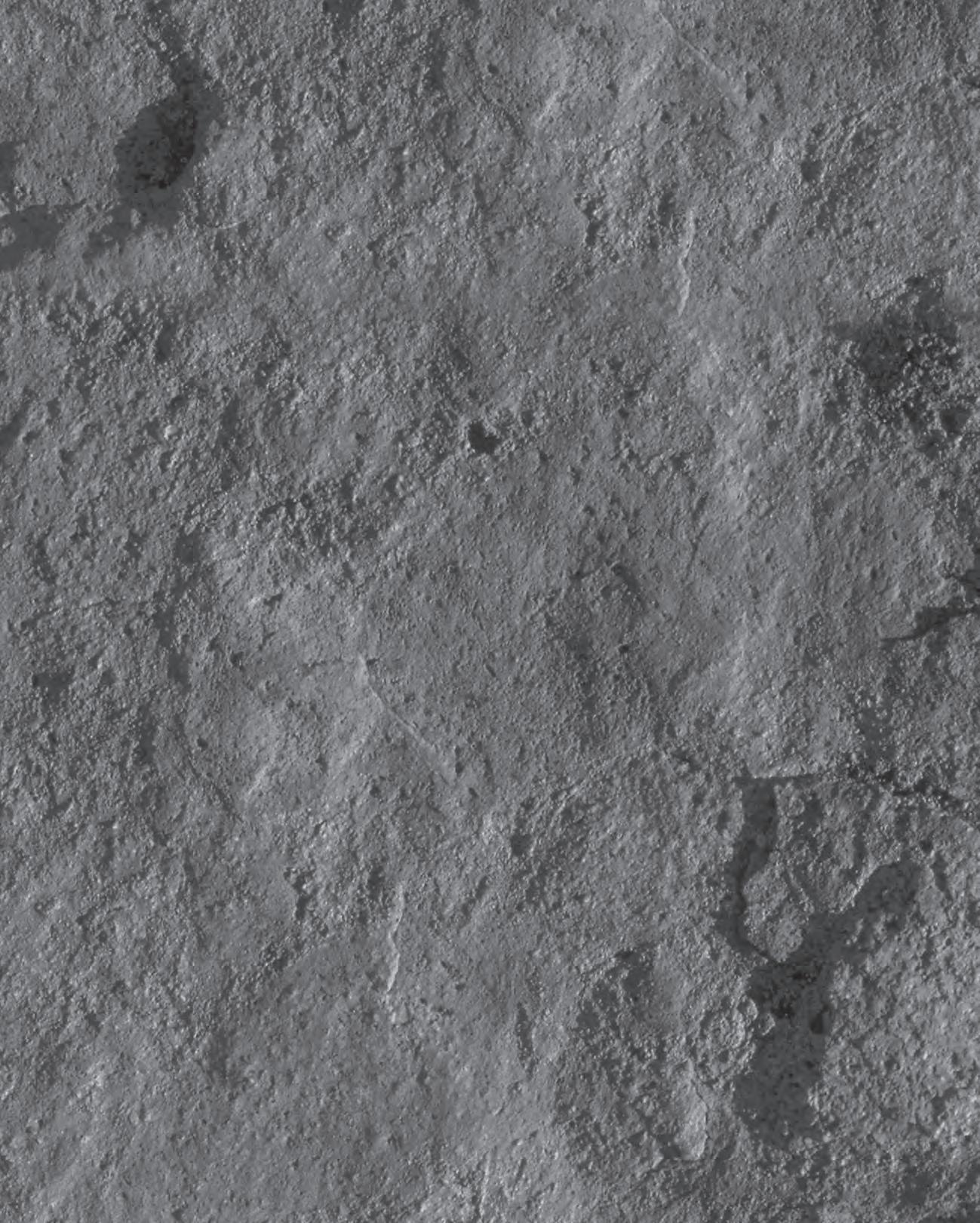

CSPG E DUCATIONAL T RUST FU ND ’ S SCHOL ARSHIP for Calgary Youth Science Fair
BEST PROJECT TO AT TEND TH E C ANADA-wIDE SCIENCE FAIR
kelcie Miller-Anderson, a grade 12 student at Bishop Carroll High School in Calgary, was awarded the CSPG Educational Trust Fund’s Canada-wide Science Fair Registration Scholarship at the Calgary Youth Science Fair on April 21, 2012.
Her project titled, “Mycoremediation of the Oil Sands,” was also awarded the $2,500 Chancellor’s Bursary from the University of Calgary, as the best project in the Calgary Youth Science Fair. kelcie had previously worked on a project using fungi and plants to remove hydrocarbons from tailings and wondered if the fungi without the plants would effectively remove hydrocarbons from tailings water and mature fine tailings. Through extensive testing she found that introducing and growing mycelium effectively removed hydrocarbons and naphthenic acids, and reduced the pH and salinity of the tailings water. Additionally, the treatment consolidated the mature fine tailings and helped introduce bacterial communities in the form of biofilms. Mycoremediation has the potential to remediate hydrocarbon spill sites as well as treat tailings.
kelcie plans to pursue a career in the petroleum industry in Reclamation Earth Sciences.
The Canada-wide Science Fair was held in Charlottetown, Prince Edward Island from May 12 to 19, 2012. Twelve top science fair award winners at the Calgary Youth Science Fair met with approximately 500 other Finalists from over 100 regions of Canada for educational experiences, social events, and to compete for 350 awards, prizes, and scholarships valued at nearly $1 million. kelcie won a Gold Medal, was named one of four Manning Young Canadian Innovators, and earned a total of $29,000 in awards and bursaries.
The 50th annual Calgary Youth Science Fair was held in the Olympic Oval at the University of Calgary, April 18 to 21, 2012. Thank you to the many CSPG members who volunteer as judges every year. The Calgary Youth Science Fair Society thanks all of its sponsors, including Platinum Level Sponsors Devon Canada, BP Canada, and the University of Calgary.
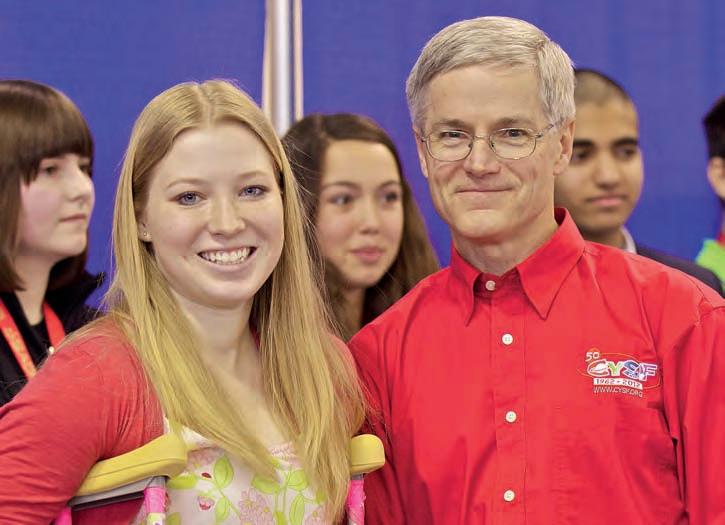
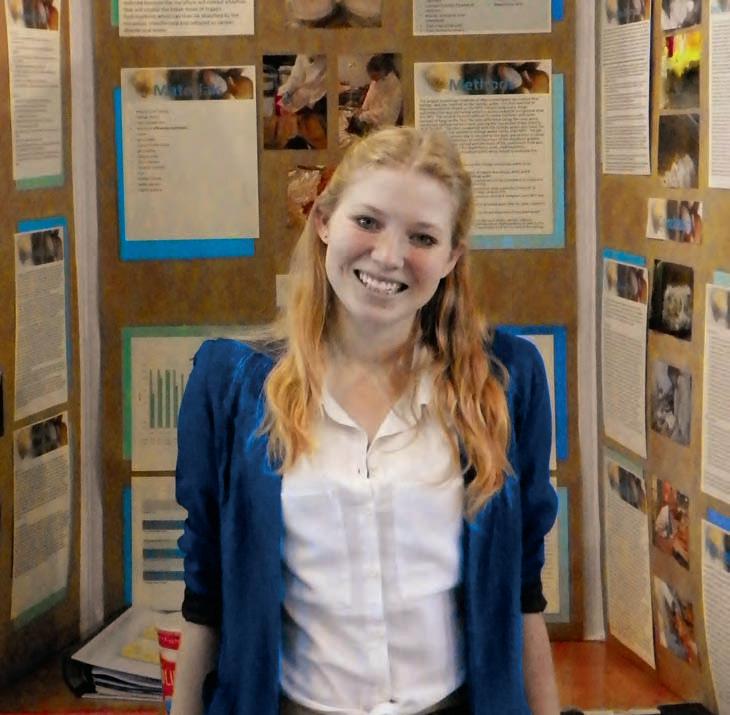
Kelcie Miller-Anderson receives award from Chuck Buckley.
Kelcie Miller-Anderson at the Calgary Youth Science Fair.

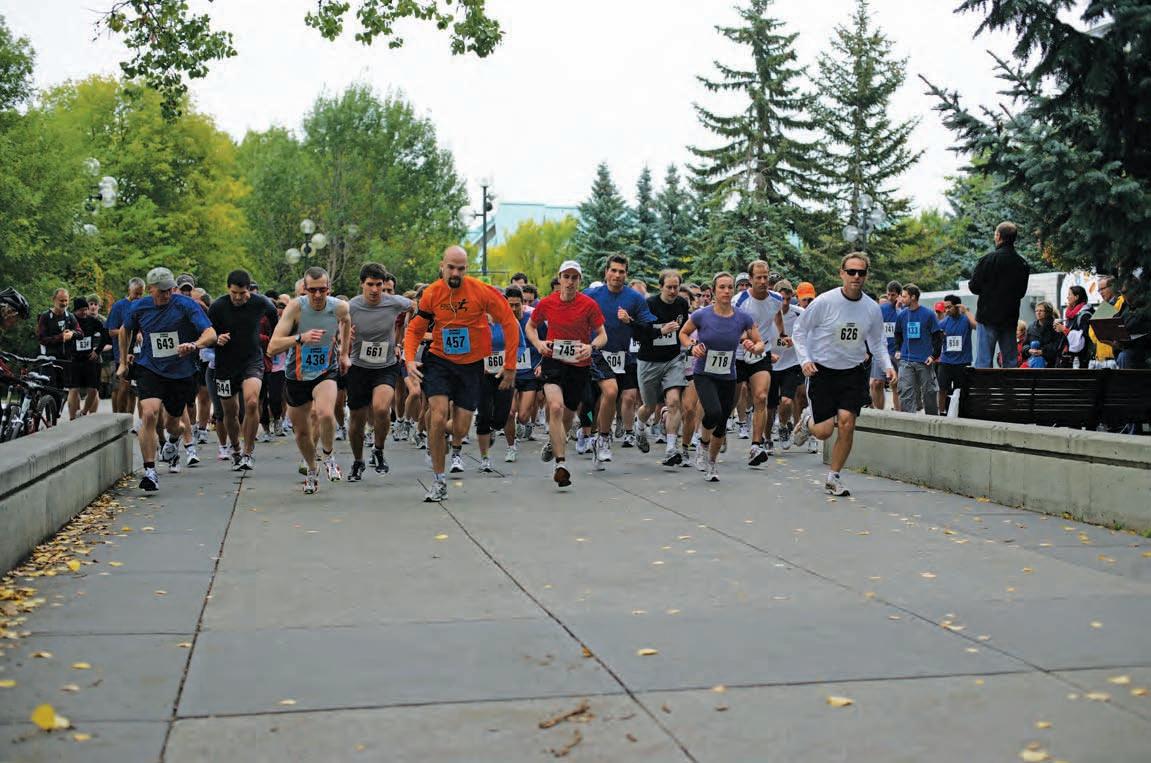
CSPG PROFESSIONAL DEVELOPMENT
SHORT COURSES & FIELD SEMINARS
SHORT COURSES & FIELD SEMINARS
SHORT COURSES
The Stratigraphic Setting of Lower and Middle Triassic Strata
Instructor: Jim Dixon
Dates: October 25th, 2012 (Morning Only)
Price: $400.00 CDN Member
$525.00 CDN Non-Member
The Architecture of Fluvial Reservoirs
Instructor: Andrew Miall
Dates: October 25 & 26, 2012
Price: $870.00 CDN Member
$995.00 CDN Non-Member
Writing for Earth Scientists: A One -Day Clinic
Instructor: Matt Hall
Dates: October 22, 2012
Price: $570.00 CDN Member
$695.00 CDN Non-Member
Sequence Stratigraphy: Principles and Applications
Instructor: Octavian Catuneanu
Dates: October 22 & 23, 2012
Price: $1,045.00 CDN Member
$1,170.00 CDN Non-Member
Fluvial Stratigraphy
Instructor: John Holbrook
Dates: October 24 & 25, 2012
Price: $915.00 CDN Member
$1,040.00 CDN Non-Member
FIELD SEMINARS
Stratigraphy and Hydrocarbon Systems of the Sappington (Bakken/Exshaw) and Three Forks Formations in Western Montana
Instructor: Ted Doughty & George Grader
Dates: July 18th - 20th, 2012
Price: $1,375.00 CDN Member
$1,500.00 CDN Non-Member
Structure and Hydrocarbons: A Field Trip from Calgary through Kananaskis Country and Crowsnest Pass to the Rocky Mountain Trench
Instructor: Peter Jones & Peter Hews
Dates: September 6th & 7th, 2012
Price: $1,225.00 CDN Member
$1,350.00 CDN Non-Member
Geology of the Athabasca Oil Sands
Instructor: Murray Gingras & Mike Ranger
Dates: September 6th - 8th, 2012
Price: $3,900.00 CDN Member
$4,025.00 CDN Non-Member
Geology of Horizontal Wells in Liquid-Rich Reservoirs
Instructor: Deborah Sanderson & Andrew Newson
Dates: September 7th, 2012
Price: $675.00 CDN Member
$800.00 CDN Non-Member
Wabamum, Bakken-Equivalent Exshaw, and Banff Formations in Core, Cuttings, and Outcrop from Southern Alberta
Instructor: Tim Hartel, Willem Langenberg, & Barry Richards
Dates: September 14th & 15th, 2012
Price: $750.00 CDN Member
$875.00 CDN Non-Member
FIELD SEMINARS
Anastomosing Channel Belt Architecture and Reservoir Considerations of the Modern Columbia River, BC as it Applies to the Mannville in West -Central Alberta
Instructor: Peter Putnam & Derald Smith
Dates: September 5th & 6th, 2012
Price: $1,300.00 CDN Member
$1,425.00 CDN Non-Member
Anastomosing Fluvial Architecture of the Lower Tertiary Porcupine Hills Formations (Paskapoo Equivalent), Southwest Alberta
Instructor: Peter Putnam & Derald Smith
Dates: September 7th, 2012
Price: $800.00 CDN Member
$925.00 CDN Non-Member
Meander-Belt Fluvial Architecture and Reservoir Considerations (Upper Cretaceous Dinosaur Park Formation), Southern Alberta
Instructor: Peter Putnam & Derald Smith
Dates: September 10th & 11th, 2012
Price: $985.00 CDN Member
$1,110.00 CDN Non-Member

FROM THE REGULATOR'S DESK
| By Brent Fairgrieve, Alex Bolton, and George Eynon
Notes on regulatory issues for industry geologists from regulatory colleagues at the Energy Resources Conservation Board (ERCB)
GETTING YOUR A PPLICATION A PPROV ED
CSPG members are often required by their companies to make the applications to the ERCB for well or facility approvals. Some confusion can arise when nomenclature or requirements are not explained. This article is intended to explain the role of geoscientists in that process and clarify some of the potential confusion. The Energy Resources Conservation Board’s (ERCB) Directive 056: Energy Development Applications and Schedules sets out the requirements and expectations for filing well, pipeline, and related facilities and infrastructure license applications. Collectively, the ERCB refers to these as “facility applications.”
ROUTINE VS. NON-ROUTINE
APPLICATIONS
“Facility applications” may be submitted as routine or non-routine. An application is considered routine when all ERCB technical and consultation/notification requirements have been met and no outstanding objections or concerns exist from landowners, other industry participants, or members of the public. Most facility applications are submitted and processed as routine. In 2011, the ERCB processed over 33,000 well, facility, and pipeline applications as routine, compared to approximately 2,700 facility applications processed as non-routine. The routine facility application process is timely and efficient; the majority of applications are approved by the ERCB within three business days.
ROCK SHOP
However, “facility applications” may need to be submitted and processed as non-routine for a variety of reasons. First, if the application fails to meet all technical requirements outlined in Directive 056. Second, if it requests a variance from regulatory requirements or proposes the use of a novel or unspecified method, material, or process. Similarly, if the application fails to meet all consultation and notification requirements outlined in Directive 056, or there are unresolved objections or concerns.
Fourth, the ERCB has designated certain categories, such as high H2S wells and facilities, which must be submitted as non-routine. Finally, the ERCB may also direct a company to submit any application as non-routine if it contains inconsistent technical information, involves sensitive geographic or environmental areas, is the first industry activity in an area, or the applicant is on “focused or global” REFER1 status. In all these cases the application must be submitted as non-routine.
Routine and non-routine applications are processed differently; the biggest difference is that non-routine applications require longer review times. Routine applications require a specific, limited list of materials used to support the application. In contrast, nonroutine applications require more information to be submitted; the details depend on why the application is classified as non-routine.
For routine applications, a risk-based audit process is used to ensure compliance of routine applications. If selected for audit, the applicant submits a full audit package for review. This happens after approval is granted to avoid affecting turnaround time.
However, all submitted materials for non-
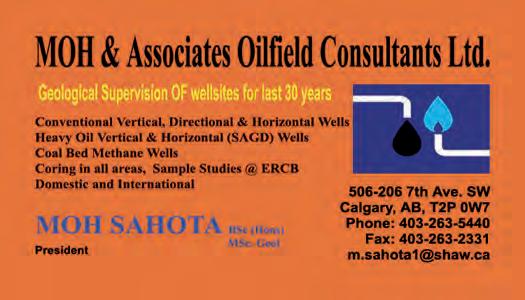
routine applications are reviewed before approval, which allows ERCB staff to ask questions or request more information. This review results in longer timelines for nonroutine applications. Companies can expedite application turnaround times by submitting accurate and technically complete applications with supporting materials, and providing timely and comprehensive responses to all ERCB supplemental information requests.
CONSULTATION EX PECTATIONS
The ERCB expects companies to identify all potentially affected and interested parties who will, or may be, impacted by a proposed development. Prior to filing an application, the applicant is expected to consult with these parties and fully disclose the planned development to interested individuals. If concerns remain unresolved following the public consultation, the application must be filed as non-routine. After the application has been filed, companies are expected to continue efforts to resolve the issues with the affected parties. Common issues of concern to affected and interested parties are discussed below.
PRESENCE OF SOUR GAS
It is imperative that companies accurately identify the sour gas zones they expect to encounter in a well. Applicants are expected to use similar geological analogues to estimate the H2S content and gas-flow rate expected in the proposed well. These values are used in the calculation of the emergency planning zone (EPZ). Historically, the ERCB has considered residents within the EPZ to be persons who may be directly and adversely affected by the application.
(Continued on page 38

CORPORATE MEMBERS
ALLEn GEOPHYSICAL COn SULTInG LTD
APACHE CAnADA LTD
APEGA
BAkER ATLAS
BDO CAnADA LLP
BLACk SWAn EnERGY
BLUEBACk RESERVOIR
CAnADIAn nATURAL RESOURCES LTD
CASE Y & ASSOCIATES
CEnOVUS
CSEG FOU nDATIOn
COnOCOPHILLIPS CAnADA LIMITED
DEVOn C AnADA CORPORATIOn
EnCAnA
EnERPLUS CORPOR ATIOn
E xxOn MOBIL UP STREAM RESEARCH
COM PAnY
GEOLOGIC SYSTEMS LTD
GEOSTRATA RESOURCES InC.
GEOVARIAnCES
HALLIBURTOn
H U nT OIL COMPAnY OF CAnADA
HUSkY EnERGY InC.
IHS
IMPERIAL OIL RESOURCES
JEWELSUITE
LED SIGn S
LIT TLE ROCk DOCUMEnT SYSTEMS
LORInG TARCORE LABS
MJ SYSTEMS
MURPHY OIL COMPAnY
nE xEn InC . PARADIGM
PEnn WEST PETROLEUM LTD.
PETROCRAFT PRODUCTS LTD.
PLUSPETROL S.A.
ROkE TECHnOLOGIES
ROx AR
RP S EnERGY C AnADA LTD.
SCHLUMBERGER
SHELL CAnADA LIMITED
SIGMA E xPLORATIOn S InC.
S PROULE ASSOCIATES LIMITED
STATOIL
SU nCOR EnERGY InC .
TALISMAn EnERGY InC .
TOTAL E&P CAnADA LTD.
TOURMALInE OIL CORP.
U nITED OIL AnD GAS COn SULTInG
WEATHERFORD LABORATORIES
AS OF JUNE 10, 2012
CSPG welcomes our 2012 Corporate Members! The benefits of being a corporate member include:
• Recognition in the monthly Reservoir and quarterly Bulletin
• One associate membership
• Reserved tables at the technical luncheons with your company logo
• One f ree pass to the CSPG Core Conference
…and more! Contact Kasandra Klein at kasandra.klein@ cspg.org to be a corporate member today!
IMPACT ON AGRICULTURE OPERATIONS AND OTHER SURFACE USES
Companies are encouraged to minimize the surface footprint and select locations that lessen the disruption to landowner activities. Directional drilling and the use of multi-well pads are encouraged, where appropriate and technically feasible, to minimize the impact to agricultural operations and other land uses. If this is impractical, an explanation is required to support the well’s surface location. Should parties object to a proposed surface location, the well license could be denied if the applicant has failed to fully evaluate alternative locations.
SETBACK IMPLICATIONS
All facilities have setback distances associated with the development that can affect some landowners by limiting activities or property development within the setback. Similar to the impact on agriculture operations, Directional drilling to access the target zone might easily resolve this issue.
IMPACT ON GROUNDwATER (wATER w ELLS) AND HY DRAULIC FRACTURING
The public is often concerned about the impact that drilling and completion operations might have on groundwater. Applicants should disclose their mud programs, casing, drilling, and completion operations to demonstrate how aquifers will be protected. Given public concern over hydraulic fracturing operations, companies should explain to area residents the relationship between the oil or gas target depth and groundwater aquifers. This includes supplying local water users with the vertical distance between the base of groundwater and the target depth, the role of intervening caprock layers, as well as the ERCB casing and cementing requirements, that prevent transmission of hydraulic fracturing fluids to the aquifer,
FUTURE DEV ELOPMENT
In many cases, affected and interested parties want to understand what the total development footprint will look like when the resource is fully exploited. While the ERCB acknowledges this can be a challenging question to answer in the early stages of an exploration play – and competitiveness issues must be taken into account – providing a “best estimate” of the total development potential when the first well is licensed can be useful. It helps both the company and those potentially affected by the project to identify all reasonable potential impacts. The ERCB also strongly encourages full disclosure as early as possible in the development program.
NON-ROUTINE APPLICATIONS AND PUBLIC HE ARINGS
In addition to a longer review time, a nonroutine application could result in a public
hearing before a Board panel. While the majority of non-routine facility applications are processed in less than 60 days, a Board hearing could last several months. Once the hearing commences, the company could lose the opportunity to reach a mutually agreeable resolution with the objecting party as the panel will determine whether to approve or deny the development under defined conditions. There might also be a subsequent review of a hearing decision through the ERCB itself or in the Court of Appeal of Alberta.
THE ROLE OF GEOSCIENTISTS IN THE APPLICATION PROCESS
Geoscientists can and should play an important role in ensuring a timely and efficient approval process. Significant delays in the approval process can be avoided by ensuring applications are technically complete and stakeholder concerns are understood and addressed to the greatest extent possible. Geoscientists can assist with the preparation of technically complete applications by being familiar with ERCB regulatory requirements and ensuring required geoscience and other information is complete and accurate. Where novel drilling or completion methods are being employed, or variances to regulatory requirements are sought, geoscientists can help ensure the rationale for these requests is clearly articulated and the appropriate supporting materials are provided as part of the application.
Finally, geoscientists can help indentify alternative locations and development scenarios to address landowner concerns or help landowners and other stakeholders understand how the regulatory requirements and project design will minimize the potential for adverse effects.
It is all too easy for us as geoscientists, in the excitement of developing a prospect and advancing the application, to forget the people who might be affected by the wells, pipelines, and facilities. However, both industry and regulators have a professional obligation to explain the impacts to local residents, regardless of how harmless we think they might be. This is especially true with respect to the precautions the regulator requires and that industry implements. As geoscientists, we need to be more proactive in helping allay public concerns; sometimes this needs to be done face-to-face at local community meetings.
Putting a public face on the oil and gas sector can prove extremely effective for everyone involved.
Brent Fairgrieve, P. Geol is a Senior Advisor in the ERCB’s Applications Branch. Alex Bolton, P. Geo. and George Eynon, P. Geo. are both Board Members with the ERCB.
1The ERCB uses REFER status to identify companies with outstanding compliance issues with respect to one or more compliance categories or ERCB groups. Companies on Global REFER status have all of their applications processed as Non-Routine. Companies on Focused REFER status have applications for certain types of activities or operations processed as Non-Routine.
